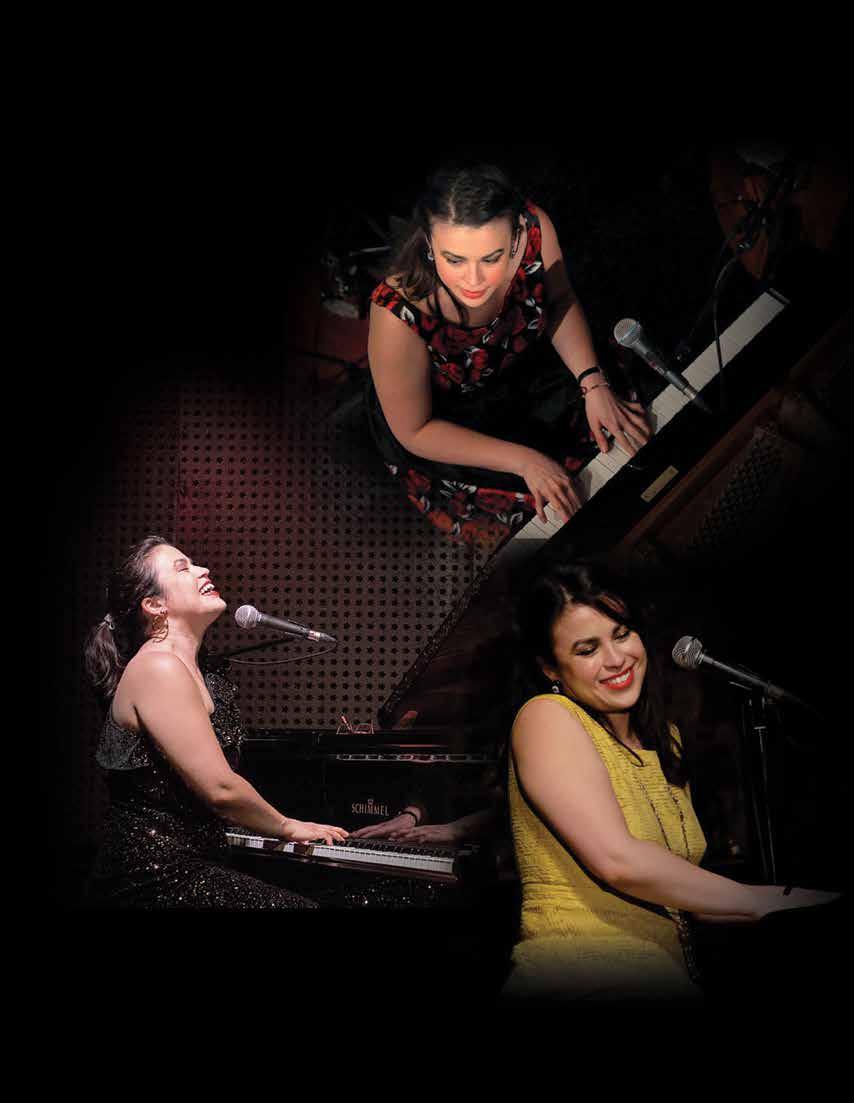

July / August 2020 Volume 48 Issue 4 www.njjs.or g Magazine of the New Jersey Jazz Society Dedicated to the performance, promotion and preservation of jazz. Champian Fulton Live From Her Living Room
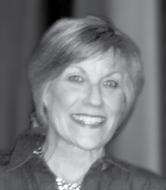
ALL THAT’S JAZZ!
By
Halpin President,
The past several months have been a real test of our collective strength and resilience, physically, emotionally, spiritually and financially.
As I’ve searched for the words to address the impact and the horrors of the deeply disturbing violence in America - both as an individual and as the president of this organization, I find myself drawing from messages and input I’ve received from the Louis Armstrong House Museum, friends and colleagues Stephen Fuller and Don Braden, and pianist Emmet Cohen. With their permission, I’m sharing the following collective message with you:
Racism, bigotry, and discrimination have sadly plagued our country for centuries. As an organization dedicated to the performance, promotion and preservation of jazz – the American art form created and molded in Black communities, the New Jersey Jazz Society must stand in solidarity with our Black brothers and sisters and peacefully, yet firmly, protest the violence that has unjustly taken so many.
We mourn the tragic and senseless deaths of George Floyd, Breonna Taylor, Ahmaud Arbery, and too many others. We empathize deeply with the families and friends of all those who are suffering not only the loss of a loved one, but also of a member of their communities.
A more equitable world may not be built without a struggle, but our actions as empathetic human beings will ensure that we get closer every day and that each person in our country, regardless of race and national origin, are able to live happy, healthy, and prosperous lives, and that such lives are enjoyed without fear.
Difficult conversations are taking place, and it seems voices are being heard louder and more clearly than ever before. Despite all of the strife and hostility, there is hope.
Hope is one of the key elements of life, and also of jazz. When Louis Armstrong climbs up to the highest note at the end of the tune - that’s a musical embodiment of hope. When John Coltrane intensely and carefully unfurls his “sheets of sound” over a smoldering rhythm section - that also signifies hope. The expression of hope can arise from any number of personal or communal experiences, including those of pain, sacrifice, and triumph and reaffirm the healing power of music and community. The history of jazz is embodied with instigating change, for being on the forefront of integration both here and abroad. Jazz is an art form for everyone. Together, let’s DO better for all and BE better for ALL.
Silence is NOT an option!
On the Cover:
Champian Fulton photos, clockwise from bottom left, by Robert Hale, D. Rimbault, and Antonio Narvaez Dupuy
Correction:
The photo of Bucky Pizzarelli in the SOPAC ad on page 27 of the May/June issue of Jersey Jazz was taken by Tom Salvas. The photo credit was inadvertently omitted.
JJA
James
Simply
Wharton’s Summer Jazz Listening Hour .39

2 July / August 2020
COLUMNS All That’s Jazz! ....................... 2 Editor’s Choice ...................... 4 Letters to the Editor .................. 5 Dan’s Den .........................30 Not Without You! ...................31 Guest Column: Gene Perla ...........37 From the Crow’s Nest ...............38 ARTICLES/REVIEWS Champian Fulton: Tunes from Home 6 Remembering Those We Have Lost ..... 8 Big Band in the Sky .. .................12
Star:
Sakamoto
Academy Virtual
Band ....16
Rising
Nana
..........14 Newark
Jazz
Baritone
the Year 18
Saxophonist of
Taylor’s American Standard
.. 20-21 Talking Jazz: Rene Marie 22 Other Views ........................26
Timeless
Radio on njjs.org .....31
The Eddy: Music Drives the Drama ....32
YOU TO OUR ADVERTISERS: Arbors
& Shivas, Mark Clemente, James Pansulla, Jazzdagen Tours,
Ocean County College, Sandy Sasso, Shanghai Jazz, WBGO
Cydney
NJJS IN THIS ISSUE THANK
Records, Bell
NJPAC,
I’m saddened to report the death of Jack Sinkway - longtime NJJS member, past board member, jazz enthusiast and generous patron. The board and I wish to extend our deepest condolences to Jack’s family and friends. His quiet manner and dedication to this organization - and jazz at large - will be greatly missed. Please see page 36 for more information about his life and legacy.
• • •
The Board and I also extend our deepest condolences to the family and friends of Holli Ross - longtime NJJS member, newly appointed advisor, beloved jazz singer, dedicated music educator, professor and voice therapist. It was announced in January that Holli would be working to help further shape our college partnerships scholarship initiative and student outreach program. She was so energetic about this project and will be greatly missed with these endeavors. Please see page 10 for more information about her life and legacy.
• • •
If we’ve learned anything throughout the Covid-19 pandemic it’s that change is here to stay! The creativity that has emerged via virtual online platforms from musicians, venues, cultural institutions, etc., has been amazing. Individuals and organizations have embraced technology to stay connected, productive and engaged with their audiences, presenting a vast array of incredible new and archived content. To this end, I hope you’ve enjoyed many of these offerings and that you’ll add Jay Daniels’ Simply Timeless Radio show - now available on the NJJS website www.njjs.org - to your ‘to enjoy’ list! For more information, please see page 31.
• • •
In an ongoing attempt to more efficiently manage administrative costs and reduce USPS mailings, we’ve printed your membership expiration date above your name in the address box on the back of your magazine. Turn it over and take a look! You now know your membership expiration date and can renew online, via Paypal or credit card, at www.njjs. org on the “Join & Support/Membership” page. You can also renew by check. Please note “Membership” and your email address on the memo line and mail to New Jersey Jazz Society, P.O. Box 223, Garwood, NJ 07027. Your membership is vital to the operations of NJJS, and we thank you for your continued patronage.
• • •
Every aspect of the jazz industry has been turned upside down with this pandemic and the production of Jersey Jazz is no exception. Please help keep this publication in print with a donation to help cover the shortfall of lost advertising revenue. Donations can be made on our website www.njjs.org/Donate/Donation Levels or by check. Please note Jersey Jazz Donation in the memo line. NJJS address above.
• • •
If you’ve come to rely on Amazon for online shopping, please support NJJS and “Turn your Amazon purchases into a force for good.”
NJJS has joined the AmazonSmile Gives program where 0.5% of the price of your eligible smile.amazon.com purchases will go directly to us! It’s the same Amazon you know but a separate website. Same products, same service – but to generate donations you must ALWAYS SHOP AT www.smile.amazon.com.
Log on to www.smile.amazon.com and SELECT New Jersey Jazz Society (Summit, NJ) as your BENEFICIARY, then shop as you normally do. Please tell your friends and family members about this amazing opportunity for us. Thank you in advance for helping to support NJJS and the performance, promotion and preservation of jazz. It’s a win-win partnership!


Cydney Halpin President email: pres@njjs.org
Jay Dougherty Executive VP email: vicepresident@njjs.org
Dave Dilzell Treasurer email: treasurer@njjs.org
Pete Grice VP, Membership email: membership@njjs.org
Sanford Josephson VP, Publicity email: sanford.josephson@gmail.com
Mitchell
Irene Miller Recording Secretary
Jack Stine Co-Founder
Mike Katz Immediate Past President DIRECTORS
Ted Clark, Cynthia Feketie, Stephen Fuller, Carrie Jackson, Mike Katz , Peter Lin, Caryl Anne McBride, Robert McGee, James Pansulla, Stew Schiffer, Marcia Steinberg, Elliott Tyson, Jackie Wetcher ADVISORS
Don Braden, Al Kuehn, Bob Porter, Holli Ross www.njjs.org
Printed

July / August 2020 3 Magazine of the New Jersey Jazz Society Volume 48 • Issue 4 USPS® PE6668 Jersey Jazz (ISSN 07405928) is published bi-monthly for members of The New Jersey Jazz Society P.O. Box 223 Garwood, NJ 07027 908-380-2847 info@njjs.org Membership fee is $45/year. Periodical postage paid at West Caldwell, NJ. Postmaster please send address changes to P.O. Box 223 Garwood, NJ 07027 All material in Jersey Jazz, except where another copyright holder is explicitly acknowledged, is copyright ©New Jersey Jazz Society 2020 All rights reserved. Use of this material is strictly prohibited without the written consent of the NJJS. Sanford Josephson Editor email: editor@njjs.org Steve Kirchuk Art Director email: art@njjs.org Fradley Garner International Editor email: fradleygarner@gmail.com Mitchell Seidel Contributing Photo Editor email: photo@njjs.org Contributing Editors Dan Morgenstern, Bill Crow, Schaen Fox, Sandy Ingham, Joe Lang Contributing Photographers Seth Cashman, Christopher Drukker, Patrick Hilaire, Lynn Redmile, Mitchell Seidel NEW JERSEY JAZZ SOCIETY OFFICERS 2020
Seidel VP, Music Programming music@njjs.org
by: Bernardsville Print Center

EDITOR’S CHOICE
Don Braden, Joris Teepe: ‘Spirit’ of Herbie Hancock
By Sanford Josephson
On November 15, 2019, about 300 people packed Jazz at the Club in The Hague, The Netherlands, to hear the Don Braden/Joris Teepe Quartet pay homage to Herbie Hancock. Fortunately, for those of us who couldn’t be there, the concert was recorded for a new album, In the Spirit of Herbie Hancock, released June 17 on the O.A.P. Records label.
The album contains six Hancock classics: “Maiden Voyage”, “Watermelon Man”, “Actual Proof”, “Speak Like A Child”, “Butterfly”, and “Driftin’” There are also original compositions -- “Ingenious Catalyst” by Braden and “Role Model” by the Dutch bassist Teepe. The only track not associated with Hancock is Jerome Kern’s “Yesterdays”.
Braden is a student of jazz history, and there are three saxophonists among his top influences who are closely associated with Hancock. Dexter Gordon appeared on the original recordings of “Watermelon Man” and “Driftin’” and George Coleman performed on “Maiden Voyage”. The first two tunes were on the 1962 Blue Note release, Takin’ Off, and “Maiden Voyage” was the title track of a 1965 Blue Note album. Benny Maupin, who played on Hancock’s “funk stuff”, can be heard on “Actual Proof” and “Butterfly”, recorded on the 1974 Columbia album, Thrust “Dexter,” said Braden, “is probably among the top three of my influences. I love his sound, feel, intelligence, melodic beauty; and he’s harmonically astute.” Coleman’s solo on Jimmy Van Heusen’s “I Thought About You” on Miles Davis’ My Funny Valentine album (Columbia: 1964) was, in Braden’s opinion, “a top 10 jazz solo.” And, he’s also a fan of Coleman’s solo on Hancock’s “Eye of the Hurricane” from the Maiden Voyage album. “He’s similar to Dexter in that he’s very harmonically astute. I got to hang with him during my Interim run at Harvard (For three years, Braden was interim Conductor of the Harvard University Jazz Combo Initiative). He and Harold Mabern were my last guests. I’m honored to be in his presence anytime.”
Maupin, Braden said, “could play wrong notes and make them sound right. He’s just so unique on a bunch of Herbie records. He’s not avantgarde, but he has a completely personal approach to the harmony. He has a beautiful sound and plays flute and oboe on some of Herbie’s records. ‘Butterfly’ is one of my favorite tunes. I played soprano on the solo and alto on the melody.”
Hancock, he added, “has so many amazing tunes. I did an arrangement of ‘Maiden Voyage’ years ago on a previous album. ‘Ingenious Catalyst’ came from when Herbie was our featured theme during one of my Harvard years. The program was called ‘The Musical World of Herbie Hancock’. I wrote this tune for that. He was an ingenious catalyst. He got it from Miles -- put a band together and create magic. That’s Herbie and Miles and Art Blakey.” All the other arrangements for the album were written by Teepe, who has collaborated with Braden for more than 25 years. The other members of the quartet were Rob Van Bavel, a Dutch pianist influenced by Oscar Peterson and Bill Evans, and American drummer Owen Hart, Jr., who has been a longtime resident of The Netherlands.
In case you’re wondering how a Jerome Kern tune ended up being part of a concert/album dedicated to Herbie Hancock, there is a simple explanation. “The concert was two hours,” Braden said, “and we had eight tunes. There was a standing ovation, so we said, ‘Let’s play a standard.’” No disrespect to one of our great American composers, but I don’t think Jerome Kern could have ever imagined “Yesterdays” having the energetic intensity it does on this album.
As of now, the album will only be digitally released in the United States, available on such outlets as iTunes and Apple Music.
About NJJS
Founded in 1972, The New Jersey Jazz Society has diligently maintained its mission to promote and preserve America’s great art form – jazz.
To accomplish our mission, we produce a bi-monthly magazine, Jersey Jazz; sponsor live jazz events; and provide scholarships to New Jersey college students studying jazz. Through our outreach program Generations of Jazz, we provide interactive programs focused on the history of jazz
The Society is run by a board of directors who meet monthly to conduct Society business. NJJS membership is comprised of jazz devotees from all parts of the state, the country and the world. Visit www.njjs.org or email info@njjs.org for more information on our programs and services.
MEMBER BENEFITS
10 FREE Concerts Annually at our “Sunday Socials”
Bi-Monthly Award Winning Jersey Jazz Magazine - Featuring Articles, Interviews, Reviews, Events and More.
Discounts at NJJS Sponsored Concerts & Events.
Discounts at Participating Venues and Restaurants
Support for Our Scholarship and Generations of Jazz Programs
Musician Members
FREE Listing on NJJS.org “Musicians List” with Individual Website Link
FREE Gig Advertising in our Bi-monthly eBlast
The Record Bin
A collection of CDs & LPs available at reduced prices at most NJJS concerts and events and through mail order www.njjs.org/ Store
JOIN NJJS
Family/Individual $45 (Family includes to 2 Adults and 2 children under 18 years of age)
Family/Individual 3-Year $115
Musician Member $45 / 3-Year $90 (one time only, renewal at standard basic membership level.)
Youth $15 - For people under 21 years of age. Date of Birth Required.
Give-A-Gift $25 - Members in good standing may purchase unlimited gift memberships. Applies to New Memberships only.
Fan $100
Jazzer $250
Sideman $500
Bandleader $750
Corporate Membership $1000
Members at Jazzer level and above and Corporate Membership receive special benefits. Please contact Membership@njjs.org for details.
The New Jersey Jazz Society is qualified as a tax exempt cultural organization under section 501(c)(3) of the Internal Revenue Code, Federal ID 23-7229339. Your contribution is tax-deductible to the full extent allowed by law.
For more Information or to join, visit www.njjs.org

4 July / August 2020
Readers Respond to Our Last Issue
To the Editor:
First of all, I simply want to say THANK YOU! When I saw the beautiful cover photo of my dad (Jersey Jazz, May/June 2020) I was so moved and grateful.
Your tribute to my dad is something my family will always cherish. Particular thanks to Sanford Josephson for “There is Only One Bucky”. He truly captured Bucky’s joy, his humanity and his lifelong love for the guitar.
I also enjoyed reading the heartfelt quotes from our dear friends Dick Hyman, Frank Vignola, Houston Person, Aaron Weinstein, Rossano Sportiello, Charlie Apicella, and Ed Laub. As Dan Morgenstern so eloquently noted in his tribute: No musician, no singer, whoever shared a note with Bucky could fail to love him.
A big special thanks and a hug to Rachel Domber at Arbors
Records. Rachel and Mat were such a special part of Bucky’s life –including my mom, Ruth. They were always passionate about the music and so full of joy. Musicians and especially my family are so grateful for their support and love. The many jazz fests were so much fun!
Thank you also to Ocean County College, Metuchen Jazz, South Orange Performing Arts Center, and Morristown Jazz & Blues Festival for their loving tributes as well.
And another big hug to Cydney Halpin for creating such a beautiful edition filled with wonderful loving tributes. I’m sending copies to friends all over the world!!
My dad once said, “I just want to be known as a guitar player. I love to play guitar, it’s never a job for me. The instrument has been wonderful to me and my family.”
My family is ever grateful to Jersey Jazz for this beautiful salute to our father. He would be so thrilled and very proud as well,
All my love and thanks,
Mary Pizzarelli
To the Editor:
I’m speechless and overwhelmed with emotion. Thank you.
Martin Pizzarelli
To the Editor:
The May/June issue issue of Jersey Jazz is really great! Excellent choice of articles and great writing. Thank you for all you do. Fabulous!
Lynne Mueller
Metuchen Jazz
To the Editor:
The May/June issue of Jersey Jazz was a really special issue for us down here in Florida, with mentions of Bucky and John, Charles McPherson and the [Sarasota Jazz] Festival, Dick Hyman, etc.
Here’s hoping for an exciting festival next year -- but not the kind of excitement we’ve been through this year.
Jo Morello
Sarasota Jazz Club
To the Editor:
Fabulous edition, and it is a wonderful tribute to Bucky.
Rachel Domber Arbors Records


July / August 2020 5
LETTERS TO THE EDITOR
• • •
• • •
• • •
CHAMPIAN FULTON
Music From Her New York Apartment Reaches Fans Everywhere
By Sanford Josephson
The North Carolina Jazz Festival, held from January 24-26, in Wilmington, NC, was probably one of the last live jazz festivals before the coronavirus shutdowns began. As Priscilla Life reported in the March/April issue of Jersey Jazz, the closing night of the event had a couple of “goose bump” moments. One of them occurred after the performance of bassist/vocalist Nicki Parrott’s quartet consisting of tenor saxophonist Houston Person, trumpeter Bruce Harris, drummer Chris Gelb, and pianist/vocalist Champian Fulton. “Midway through the set,” Life wrote, Parrott “kicked the boys off the stage, and she and Fulton performed a duet of what they called a ‘Blue Moon’/’Moonglow’ mashup, trading lyrics from each song and finally blending their voices at the end. Standing ovation time.” “That was a wonderful weekend,” Fulton recalled in early May. “It was my first time to participate in a jazz party setting where all the musicians mix and match. Nicki and I performed together a few times last year, and she asked me if I’d join her on her arrangement of ‘Blue Moon/Moonglow’. The two songs don’t fit together harmonically, but she’s so much fun to be on stage with. It was a really special moment.”
The way the mixing and matching worked, Fulton explained, is that, “Every set was 30 minutes long. There were two piano players -myself and Rossano Sportiello. We would each play every other set. Each set had a different leader. It’s a lot of fun. You play tunes you wouldn’t normally play. It’s a real creative environment.”
Fulton’s performance schedule was intentionally light in February and March because she was planning a five-week European tour beginning in April. It was to include Sweden, Germany, and London, culminating with five nights in Vienna. “I was also supposed to perform in Louisville at the end of March, and tonight (May 5) I was supposed to have a show at The Metropolitan Room in New York.”
All that changed, of course, but beginning Sunday, March 28, Fulton began presenting live video concerts on Facebook and YouTube from her New York apartment at 5 p.m. (2 p.m. in Los Angeles, 10 p.m. in London, 11 p.m. in Paris, 7 a.m. Monday in Sydney, Australia). “I’ve really been enjoying these online concerts a lot,” she said. Viewers log on from all over the world. On a typical night, Fulton might welcome “Joseph from Barcelona” or “Chris from Cincinnati.” And musicians: “Nicki Parrott is out there . . . Oh, my God, Buster Williams is watching!”
Some nights, she said, “There are themes, and some weeks I just play. The audience has really grown. The first night, we had 50 to 75 viewers. For my Ella-themed concert on April 26, we had almost 500 constant viewers. It changes all the time, but I never knew I had people listening to my music in Kenya.” Selections range from Vincent Youman’s “Tea for Two” because “My mother wants to hear it,” to Noel Coward’s 1932 composition, “I’m Mad About the Boy” from Fulton’s 2016 Gut String Records album, After Dark. On the Ella-themed show, tunes included “When Your Lover Has Gone” (James Horner/Elinar Aaron Swan) “from the Ella and Oscar Pablo album” and several songs from the Verve Ella Sings George and Ira Gershwin Songbook.

In between her own online concerts, Fulton also guested on other virtual shows. For example, On June 5, she and saxophonist Nick Hempton performed on the New Brunswick Jazz Project’s Facebook page. Fulton appeared live on the New Jersey Jazz Society Facebook page from 3-4 p.m. on Sunday, June 14. This video concert replaced her scheduled appearance at the NJJS Social, which would have been held at Shanghai Jazz in Madison, if not for the pandemic.
Fulton’s first influence as a singer, she said, was Dinah Washington, who she discovered when “I was three years old . . . But there was also Billie Holiday, Ella Fitzgerald, and Sarah Vaughan. And, I really love the blues: Jimmy Rushing, Joe Turner, Jay McShann. I’m really drawn to pianists who use block chords such as Wynton Kelly and Red Garland. And, I listen to Art Tatum every day.” She particularly relishes the memory of seeing McShann play at a festival in Oklahoma in 2000. “He may have been one of the most swinging people I’d ever seen,” she said. “After that, I would call him on the phone, and we’d talk about music and piano playing. He loved what he did.”
An early inspiration for her was the legendary trumpeter Clark Terry, a friend of her father, trumpeter Stephen Fulton. Terry, she said, “was like a grandfather. He would visit. We would talk on the phone. I would draw pictures to send him on the road. I loved his music, so I would hang out with Clark and my dad when I was eight years old. He would give me lessons. When we were living in Iowa, I started a children’s band. Clark actually hired me for my first paying gig when I was 10, and he was 75. It was his 75th birthday party at our house. He wanted my band and me to play at the beginning. It was really fun, and I got paid. When we moved to New York in 2003, he was living in New Jersey, and I would see him frequently.”

6 July / August 2020
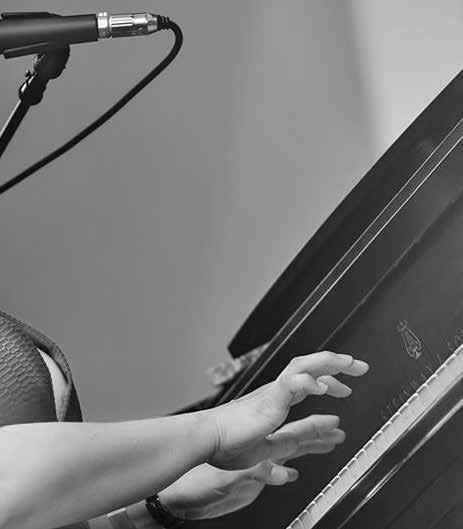
Fulton has a new album scheduled for release in August. Called Bird Song, it celebrates the centennial birthday of Charlie Parker and features tenor saxophonist Scott Hamilton. Hamilton and Fulton are “really good friends. This was a really fun project to work on. He lives in Italy now, so we work together in Europe. July has been canceled, but we do have some gigs in August we’re hoping to keep.” One of those is a six-night engagement from August 20-25 at the Global Music Foundation Jazz Summer Summit in Tuscany, Italy.
Hamilton and Fulton recorded an album together in 2017, The Things We Did Last Summer (Blau Records). Reviewing it in JazzTimes, Christopher Loudon pointed out that, “As a pianist, Fulton, a dextrous, imaginative player, blends beautifully with the astute Hamilton. Their shared inventiveness is evident across everything from a satiny meander through the title cut to a freewheeling ‘Runnin’ Wild’ and, the set’s apex, a 10-minute twinning of Illinois Jacquet’s ‘Black Velvet’ and ‘Don’cha Go ‘Way Mad’.”
Last year, Fulton teamed with alto saxophonist Cory Weeds on an album called Dream a Little... (Cellar Live). Jersey Jazz’s Joe Lang wrote that Fulton and Weeds “seem to have a natural affinity . . . make a fine duo, and should record more like this in the years to come.”
Fulton said she will try to continue the online concerts “even after the lockdown is over,” because of the positive reaction. And, there has been an unexpected benefit from them. “I have always wanted to be a Yamaha artist,” she said, “and had been trying to connect with them. They saw my Facebook Live performances and said they liked them. I actually became a Yamaha artist two weeks ago.”
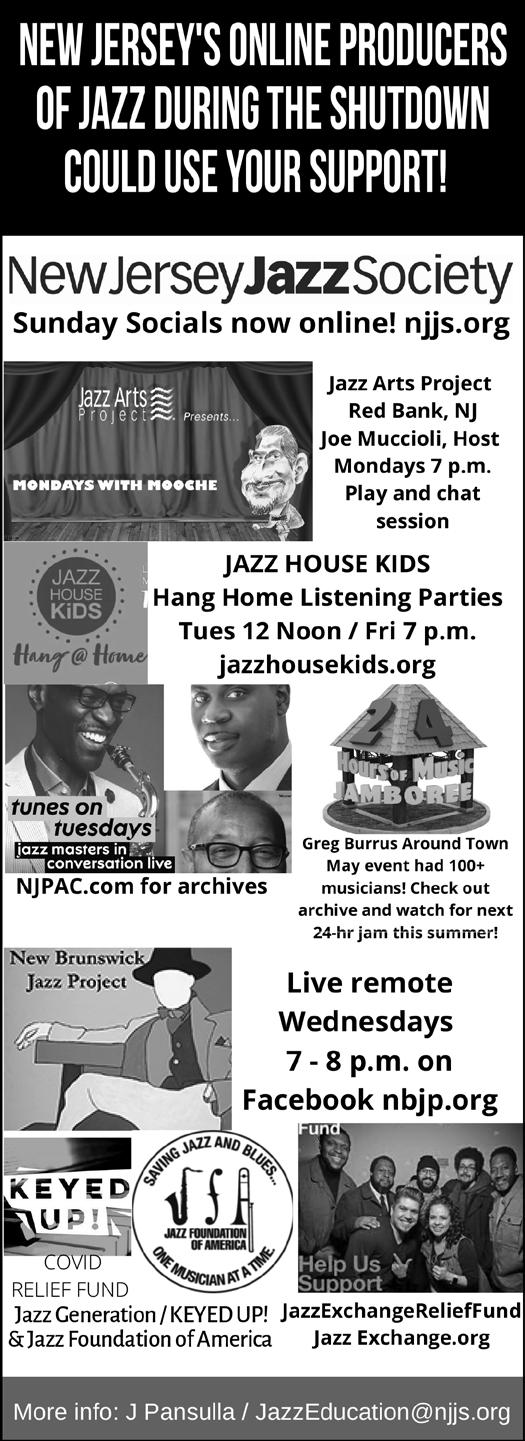

July / August 2020 7
Photo by Seth Cashman
Remembering Some of Those We Have Lost
Jersey Jazz has asked some of those closest to members of the jazz community we’ve recently lost to share personal memories. Following are tributes to Bootsie Barnes by Larry McKenna; Michael Cogswell by Ricky Riccardi; Lee Konitz by Kenny Berger; and Holli Ross by Jeff Kunkel. Complete obituaries previously appeared on NJJS’ website, and links are provided in each essay.
Bootsie Barnes
by Larry McKenna
People always said that Bootsie and I didn’t sound alike, which was true. He could play two bars and I could play two bars and right away you would say, “Oh, that’s two different people.” Our sounds were not the same, but for some reason, the way we bounced off each other was kind of perfect. We inspired each other. Sometimes it’s that way, especially if it is someone who doesn’t play exactly like you do. They might play something, and their influence is rubbing off on you, and your influence is rubbing off on them. So, the end product is a mixture of the two styles that happens to blend perfectly. (https://njjs.org/index. php/2020/04/27/philly-jazz-favorite-tenorsaxophonist-bootsie-barnes-dies-fromcovid-19/).
I read that Gerry Mulligan and Chet Baker were never that friendly, but Mulligan said he felt that chemistry with Chet Baker that he never felt with anybody else. He couldn’t explain it, but when they played together, it was like magic. It’s intangible. It just happens. When Bootsie and I played together it was always like a happy feeling as we bounced off each other.
We didn’t really socialize, except when we played gigs together. We were friendly, but we didn’t live near each other. The last time I spoke to him we had talked about getting another gig with an organ group we recorded with, but it never materialized. All of a sudden, we had this pandemic. In fact, I didn’t know that Bootsie was seriously ill until he passed away.
I think the last gig we did was about a year ago. I picked him up at his place, and we went to the gig. Afterwards, I said, “I’ll drive you home.” He said, “No I want to go to the Tuesday night jam session in Manayunk. Bootsie liked to hang out [at a bar and grill] there. I sat in with the guys, and they were after Bootsie to play, but he said, “No I already played enough tonight.” He had a

lot of friends there. I played a set with the guys and then I was ready to go home, but he wanted to stay and get a lift home from somebody else. That was the last time we actually hung out together.”
When I got an offer to play at T&T Monroe’s (a Center City Philadelphia jazz club), I learned it was because Bootsie wanted to play with me. When I asked him why, he replied, “I don’t know.” He must have thought we would make a good match up. I had met him but I didn’t really know him. I was surprised when I got that call. It was his gig, with his own band. I didn’t even know the guys in his band at that time. I had been pulled away from the jazz scene. In order to make a living, I was doing a lot of commercial bands, playing weddings and bar mitzvahs and that kind of stuff. Only about 10 percent of my work was in the jazz field.
Then a whole different set of people started hearing me on that gig. The next thing you know, Ortlieb’s opened up and we started playing there. We became known as a team, even though most of our gigs were not together. We did play quite a bit together at
Ortlieb’s and jazz festivals and other places. We never actually got to record together until 2004 when John Swana, recorded Philly Gumbo Vol. 2. It’s a very good album. All these years went by and we played many, many gigs together, but we never recorded again until two years ago when we did The More I See You CD. I thought it was really good.
Bootsie and I played together at Ortlieb’s many, many times. The guy who owned it, Pete Souders, was a sax player who really loved the music. He had a really good house band, and he hired us and people from New York. It went on for almost 25 years, which is a long time for a jazz club. They had jazz six nights a week. Also, you could go in and hang. It was not expensive. Musicians would all come in and congregate. It was a real jazz club.
Sometimes the way Bootsie would say stuff just cracked me up, and he wasn’t trying to be funny. It was the way it sounded when he would say it. When I called him about doing this last record date, he was complaining about having acid reflux. The way he described it sounded funny. In the

8 July / August 2020
Bootsie Barnes, center, and Larry McKenna, right, play for a young fan. Photo by Mitchell Seidel.
meantime, I wrote this tune, and thinking of him, I called it “Don’t Redux the Reflux.” So, we had a rehearsal for the record date two days before we actually recorded. When I handed out the arrangement for that tune, Byron (drummer Byron Landham) and Lucas (organist Lucas Brown) started to laugh. They didn’t know what the title meant, but they thought it sounded funny. Bootsie didn’t. I don’t think he made the connection. He looked at it and said, “Oh man this looks like it’s going to be hard. There’s a lot of notes there.” He was really serious about it. Then we ran it through two or three times, and he got it. When he felt confident that he knew it, he looked at the title, chuckled and said, “That’s pretty funny.” I didn’t explain the title to him. I wanted it to sink in.
(As a young adult, McKenna spent six months on the road with Woody Herman’s Thundering Herd. He is a leading light of Philadelphia’s jazz scene).
Michael Cogswell
by Ricky Riccardi
Michael Cogswell, the founding Executive Director of the Louis Armstrong House Museum, passed away on April 22 at the age of 66. For those who don’t know, he was my boss for eight years, but he was also a friend and colleague for much longer than that. He had been bravely battling bladder cancer since 2011 so his passing wasn’t a shock to me, but his loss still leaves a hole in my heart and the hearts of Louis Armstrong fans around the world. (https://njjs.org/ index.php/2020/05/01/louisarmstrong-house-foundermichael-cogswell/).
The following year, Michael attended one of my Armstrong lectures at the Institute of Jazz Studies at Rutgers, and we bonded on my initial trips to Satchmo Summerfest in New Orleans in 2008 and 2009. It was on that 2009 trip that Michael changed my life. Jon Pult was driving us back to the airport with Dan Morgenstern riding shotgun and Michael and me in the back. Michael casually remarked that the Museum recently received a two-year grant from the Institute of Museum and Library Sciences to hire someone to arrange, preserve and catalog the monumental Jack Bradley Collection. He added that I should “strongly consider” applying.
I took the hint and immediately cobbled together an application. My first reference? Jack Bradley himself. Shrewd….
On my second day at work, Michael and I took a field trip up to Cape Cod to visit Bradley. Though I had known Michael a bit over the years, it was a bit daunting to go on a road trip with my new boss on my first week on the job. He later admitted that he,
on the other but we managed to work so well together because we were united by a common goal: devotion to the legacy of Louis Armstrong. That was it.
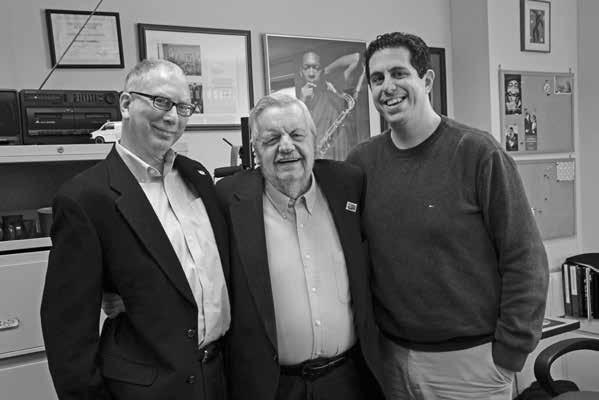
I was a fan of his work from early in my Armstrong infatuation, having read numerous articles about the Armstrong House and Archives, as well as Michael’s 2003 book, Satchmo: The Offstage Story of Louis Armstrong. In January 2006, I visited the Armstrong House for the first time and was thrilled when I saw Michael walk through the gift shop wearing a Mets cap. I introduced myself and he couldn’t have been friendlier. After visiting the archives later that day, I turned to my wife and said, “I’m going to work there one day.”

too, had some reservations. But we hit it off immediately, sharing music on the ride and having a memorable time with Jack and his wife Nancy. After that, it was smooth sailing.
Well, more or less smooth. Though we became close friends, Michael and I were pretty different as humans: he was by-thebook, I was a little looser; every word he spoke was calculated, where I tended to be more excitable; he thrived in neatness, I kept my desk like a pigpen. Occasionally, our “Odd Couple” demeanors would grate
Working with Michael did have sad moments, especially towards the end. In 1999, he asked the Louis Armstrong Educational Foundation for a grant to purchase the vacant lot across the street. After securing the property, he began talking about plans to build an Education Center across from the House Museum. Over the next decade or so, he helped raise $23 million to help fund the building. As he grew sicker from battling the cancer and dealing with chemo, he continued to give everything he had into the planning of the building, always meeting with architects, funders, exhibit designers, construction teams and more. The feeling that he wasn’t going to make it to see the completion of the new building sometimes put him in dark spirits. He was too hard on himself, sometimes acting like he had failed. That was nonsense. The truth is, no human being has done more for Armstrong’s legacy than Michael. Armstrong scholarship changed almost overnight once Michael opened the archives and made Louis’ private writings and tapes available to researchers. He opened the House Museum, the only one of its kind dedicated to a jazz musician, and watched as hundreds of thousands of visitors traveled to Corona, Queens, to see how Louis Armstrong lived. And he did help raise the $23 million for the new building and proudly stood tall at the groundbreaking in July 2017, a week before he was admitted to the hospital for the surgery that ended his career and heralded his retirement. Construction is still ongoing but the fact that Michael did not live long enough to see it completed and open to the public is tragic. We will not let the world forget it when we finally open in 2021. As one of the exhibit designers remarked upon hearing of Michael’s passing, “He is definitely the heart and soul of this place still.” He will always be.
Michael went through hell and back after retiring but he seemed to bounce back in
July / August 2020 9
From left, Michael Cogswell, Jack Bradley, and Ricky Riccardi in 2015
2019. I twice met him for lunch and we had wonderful times, reminiscing about the old days and talking about the future. He knew he didn’t have much time left, but he was at peace with it, truly grateful for the life he led.
The last time we corresponded was when I wrote to him to let him know a longtime Queens College colleague, Joseph Brostek, passed away. “Thanks for sending,” Michael wrote on March 29. “Yes, as Director of Special Events, he worked directly on the Dedication of the Armstrong Archives (1991), Opening of the Armstrong Archives (1994), First Lady Hillary Clinton’s Visit (1998), and Opening of the Louis Armstrong House (2003). A fruitful time period.” Those were the last words I received from Michael but it summed him up to a tee: rattling off one monumental accomplishment after another before almost brushing it off with the modest descriptor, “a fruitful time period.” Louis Armstrong fans will be enjoying the fruits of that time period for eternity and they will always have Michael Cogswell to thank for making it possible.
(Ricky Riccardi is Director of Research Collections at the Louis Armstrong House Museum; the author of What a Wonderful World: The Magic of Louis Armstrong’s Later Years, published by Pantheon Books in 2011; and the author of Heart Full of Rhythm, about Armstrong’s later years, to be published this year by Oxford University Press).
Lee Konitz
By Kenny Berger
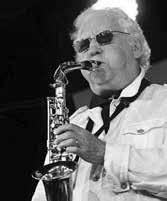
If I were asked to describe Lee Konitz, both the man and the musician, in one word, that word would be “integrity”. I had the honor and privilege of being a founding member of the original Lee Konitz Nonet in 1976. The nonet was formed to do a threeweek tour of Italy that, due to political and economic upheaval, was cancelled literally one gig at a time over the course of several weeks. This was where I had my initial first hand encounter with Lee’s integrity. After the tour was cancelled Lee felt that since we had spent so much time rehearsing and assembling a book, he owed it to us to keep the band together and try to get some work. (https://njjs.org/index.php/2020/04/18/leekonitz-perfect-foil-opposite-miles/)
Once the nonet became known as an actual working band, we were able to establish a residency of sorts at Stryker’s Pub on West 86th St. Playing alongside Lee at least once or twice a week for a couple of years was one of the most educational experiences of my life, though due to my own immaturity at the time, many of the things I learned took several years to sink in and a few more years to come out in my playing. Lee was quoted many times as saying that his goal was a state of pure improvisation and pure melody, free of any use of licks, patterns or any of the prepared material relied upon by even the greatest jazz players. The idea of preparing a bunch of material, then getting on the bandstand and performing that material was anathema to him. He said he didn’t think of chord changes while improvising (blasphemy!); he thought in terms of intervals because melodies are made of intervals. A story that illustrates this happened when I began writing for the nonet and asked Lee if there were any particular tunes he would like to have in the book, and the first one he mentioned was Wayne Shorter’s “Nefertiti”, saying (think of how few modern jazz players would use this reasoning) “I’ve always wanted a chance to play that melody”.
Hearing Lee on an almost nightly basis revealed to me the price he paid for maintaining this level of integrity. For example, due to his insistence on being in the moment and lacking an arsenal of prepared material to fall back on, combined with his incredibly high level of sensitivity to his musical surroundings, an unstable or inattentive rhythm section could positively destroy him.
Speaking of Lee’s sensitivity to his surroundings, one night at Stryker’s there
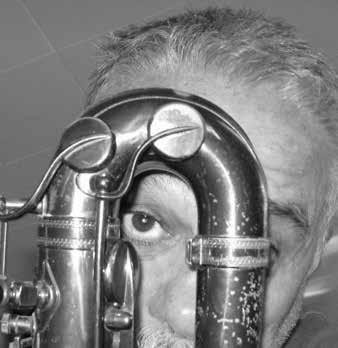
was a woman at a table in front of us who never stopped talking through the whole set. We had come to the end of a tune, and Lee was playing an unaccompanied cadenza during which the aforementioned woman kept talking at the top of her lungs. Lee took the horn out of his mouth, yelled out “You can have the next one” and continued with his cadenza. Even under ideal conditions on nights when his own playing wasn’t clicking, he would pay the price for his inability to coast, continually aiming for that zone, results be damned. The good news is these are only a few of the reasons why an aspiring saxophonist could transcribe 100 Lee Konitz solos and come away without a single hot lick or slick pattern with which to impress his or her friends or win a prize at a festival. I include Lee, along with Sonny Rollins, Wayne Shorter, Steve Lacy, Thad Jones and Bob Brookmeyer as members of a small pantheon of improvisers who always started from scratch, always stayed in the moment, and always aimed for that elusive zone. Lee Konitz found that zone more often than just about anyone.
(In addition to being a founding member of Lee Konitz’s nonet, Kenny Berger has played with trumpeter Howard McGhee and the Thad Jones/Mel Lewis Jazz Orchestra and arranged for the Dizzy Gillespie United Nations Band. Dan Morgenstern writes about Lee Konitz in Dan’s Den, page 30)
Holli Ross by Dr. Jeffrey Kunkel
Sometime in the months preceding the fall semester of 2008, as we were beginning our Jazz Studies program in the Cali School of Music at Montclair State University, I spoke with long-time friend and colleague

10 July / August 2020
Lee Konitz. Photo Credit: northseajazzfestival.com.
Kenny Berger
Darmon Meader about who might be an appropriate vocal teacher to join the roster of faculty we were establishing at the time. I had re-assumed direction of the vocal jazz ensemble in 2006 but knew that would not fit permanently in my schedule; and we now also needed a great teacher for applied jazz vocal lessons. Darmon suggested one of our fellow Maplewood residents, Holli Ross, for the position, and immediately after meeting Holli, I knew we had found our teacher. She was full of fire and energy, had a strong background as performer and teacher, and had a great reputation as a professional. Holli joined us that fall, and with only the exception of a few recent semesters as she was battling her illness (and I do mean battling!), has been with us ever since as a loyal and dedicated colleague. (https://njjs.org/index. php/2020/05/12/holli-wasser-ross-artist-ofvocalese/)
in Rio de Janeiro. She contributed beautiful lyrics for a relaxed bossa nova entitled “What a View”, and for a dark ballad as well, “No One Can Hurt Me Now”.
Although Holli’s lyrics were beautifully
This brings me to the characteristic I will most remember about Holli -- her love for her students and her dedication to them.
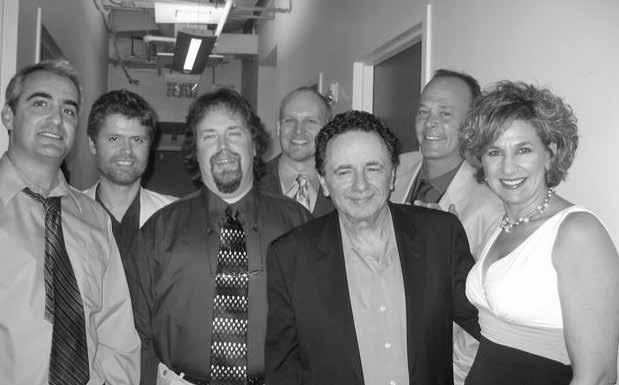
From her very first student with us, Jess Fleming (a local Montclair- based musician to this day), to her last, Allyson Latini -- who graduated just this semester while dealing with academic restrictions brought about by the Covid-19 pandemic, and for whom the best is yet to come -- Holli endeavored to prepare her students for the world of jazz. As we all know, this can be a fickle and difficult world at times, and Holli always believed the way to succeed was to show oneself to be a total professional.
Little did I know at the time that this choice would pay personal musical dividends as well, with Holli and I collaborating on two songs for my first release as a leader in 2013, Meu Coração Brasiliero, which was recorded
interpreted by Brazilian vocalist Vika Barcellos for the recording, I was fortunate enough to be able to perform these songs on multiple occasions with Holli, and even performed “What a View” with one of Holli’s top students, Emily Zapata, at the one of the annual Cali Kaleidoscope Concerts at MSU.
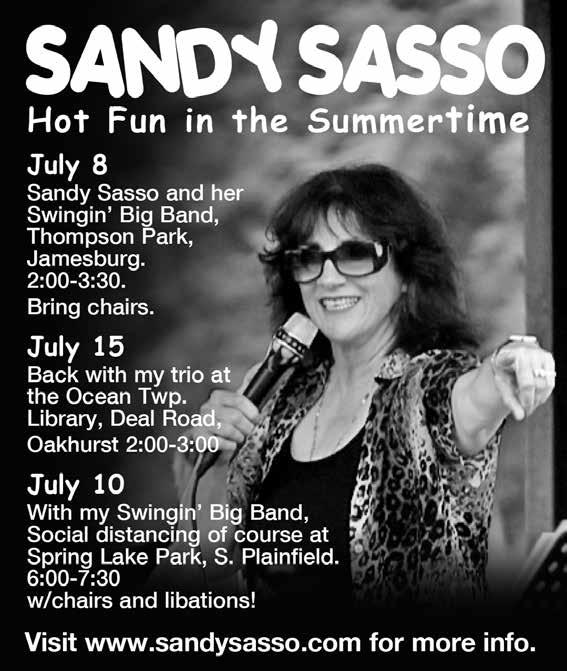

I know without question that I speak for my colleagues and the students alike at the Cali School when I say how much Holli will be missed. Along with her general approach to life, her passion for jazz, for teaching, for her family, friends, and students will not be easily replaced.
(Dr. Jeff Kunkel is Director of Jazz Studies at Montclair State’s Cali School of Music).

July / August 2020 11
From left, the late Brazilian drummer/educator Sergio Gomes; bassist/ guitarist Itaiguara Brandao; Dr. Jeff Kunkel; New York Voices' Darmon Meader; the late trumpeter Claudio Roditi; alto saxophonist Dave Bixler; and Holli Ross.
Jimmy Cobb, Last Survivor from Kind of Blue
By Sanford Josephson
When the Miles Davis Septet was beginning to record the now-classic album, Kind of Blue (Columbia: 1959), Davis reportedly said to drummer Jimmy Cobb, “Jimmy, you know what to do. Just make it sound like it’s floating.” And, according to National Public Radio’s Natalie Weiner (May 25, 2020), “It does: The perfect tension between Cobb’s signature driving cymbal beat and Paul Chambers’ relaxed walking bass line makes most people’s first jazz album one that you can -- or can’t help but -- move to.”
Jimmy Cobb, the last surviving member of
Giants of Jazz concert honoring Mabern at the South Orange Performing Arts Center. That septet played “Mr. Johnson”, a Mabern composition in memory of trombonist J.J. Johnson (Jersey Jazz, January-February 2020). On This I Dig of You, Cobb and Mabern, along with guitarist Peter Bernstein and bassist John Webber, played Mabern’s ode to trumpeter Lee Morgan, “Edward Lee”.
Cobb’s strength, Weiner wrote, “was always understatement, which meant that he didn’t necessarily get the same accolades and attention as some of his peers behind the kit. But his simplicity and intuitive feel made Cobb’s grooves a seamless art of any band’s living organism, its backbone or heartbeat.”
In addition to Kind of Blue, Cobb appeared on such other well-known Davis albums as Sketches of Spain (Columbia: 1960) and In Person Friday and Saturday Nights at the Blackhawk (originally recorded in 1961; reissued as a four-disc set by Sony Distribution in 2003).

that septet, died at the age of 91 on May 24, 2020, at his home in Manhattan. The cause, according to his wife, Eleana Tee Cobb, was lung cancer. Born on January 20, 1929, in Washington, D.C., Cobb was already playing on the jazz circuit as a teenager. He performed with Billie Holiday in D.C. and on the road with Davis and Charlie Parker.
His last album was Jimmy Cobb: This I Dig of You, released in 2019 on the Smoke Sessions label. In his review in JazzTimes, Philip Booth declared, “At 90, Cobb still has it, as he handily demonstrates . . . driving a quartet on an uncluttered frillsfree program dominated by standards, some of which he’s been playing for decades.”
The pianist on that recording was Harold Mabern, who died in September 2019. In November, Cobb played with a septet at the
Early in his career, Cobb played with saxophonist Earl Bostic, vocalist Dinah Washington, and pianist Wynton Kelly. He and Kelly collaborated for 20 years, including on two Miles Davis recordings. He also played on some of Cannonball Adderley’s early recordings, but he didn’t record as a leader until 1980
In the ‘90s, Cobb became a mentor to young jazz musicians such as the late trumpeter Roy Hargrove, bassist Christian McBride, pianist Brad Meldau, and guitarist Peter Bernstein. “Jimmy Cobb,” Meldau posted on Facebook, “was one of a handful of drummers who changed the music indelibly. The inimitable swing feel we know and love so much from him -particularly as regards his own way of what many call ‘tipping’ -- was simply not there until he gave it to us. His musicality and subtlety were unmatched. The joy he has given me as a listener for decades and playing with him for a short while is a treasure I hold in my heart.”
Added Bernstein, also on Facebook: “There are no words to describe what it felt like to play with him . . . There could not be a more unselfish musician than Jimmy Cobb.
He played for the music, for the other musicians he was playing with. His touch and sound on the drums made the other instruments sound better. His sound carried you, and his momentum was so beautiful. He was a genius of forward motion. He was a true zen master.”
Young pianist Emmett Cohen invited Cobb to perform with him on his first Masters Legacy album in 2017. “Later our friendship continued to grow,” Cohen told Jersey Jazz. “He even asked me to join his trio on a few occasions. We shared some incredible moments in different parts of the world over the years, and I especially enjoyed how he always lit up around his old friends -Harold Mabern, George Coleman, Ron Carter, Barry Harris, and Tootie Heath, among others.”
Cobb was named a National Endowment for the Arts Jazz Master in 2009. In a 2008 interview with the NEA, he described how he established his sound: “Most people, when you start out, you start out emulating somebody. Do what they do. You’d heard something that sounded good and you liked it, you’d try to play that. You did that for a while; some people get out of it, and some people don’t . . . After a while, that kind of gives you a style, because you take different things from different people’s playing that you like, and then you put it together for your stuff, and then you probably wind up in the long run with some kind of a style of your own.”
In addition to his wife, Cobb is survived by two daughters, Serena and Jaime.
Alto Saxophonist
Richie Cole: ‘Keeper of [Bebop] Flame’
Cole was born on February 29, 1948, in Trenton, NJ. Since his father owned two jazz clubs in Trenton, he was introduced to jazz at an early age and began playing alto saxophone when he was 10 years old. He won a full scholarship to the Berklee College of Music from DownBeat Magazine but dropped out in 1969 to join Buddy Rich’s big band, succeeding Art Pepper on alto. The band had just released a hit album, Mercy, Mercy on the Pacific Jazz label. The next Rich Pacific Jazz album, Buddy & Soul wasn’t nearly as popular, but it established Cole as a saxophonist on the rise.
continued on page 34

12 July / August 2020
BIG BAND IN THE SKY
Photo by Christopher Drukker


July / August 2020 13
‘Old School’ Trombonist Nana Sakamoto Learned
By
Transcribing Recordings
By Sanford Josephson
Alto saxophonist Vincent Herring first heard Nana Sakamoto play the trombone in 2017 at a Monday night jam session at Smoke, the jazz club on New York’s Upper West Side. “I heard her play one song,” Herring said, “and I knew she was special.” So special that he invited her to play with his ensemble.
The 24-year-old Sakamoto started playing trombone at the age of 10 in the big band at her elementary school in Niikappu Cho, near Hokkaido, Japan. “My older sister joined the band first,” she said, “and I got inspired by it, so I decided to join, too. I started on the trumpet, but because there were so many trumpeters and few trombonists, my teacher switched me to trombone.”
Her visit to New York in 2017 was a “sightseeing trip. As we all know,” she said, “New York is the center of jazz in the world. I wanted to come here to see the greatest musicians and hear the music from its source.” She returned to Japan but was back in New York a year later and resumed going to jam sessions at Smoke as well as the now defunct Cleopatra’s Needle. “I also knew some Japanese musicians who were living and playing here,” she said, “so they helped me a lot, too.”

of Her Jazz Heroes
Herring, who describes Sakamoto as “an excellent reader, a great improviser, and a nice young lady,” paired her with a young “saxophone prodigy from Japan named Erena Terakubo. The two of them together are amazing,” he said. “Nana and Erena are on the way to being players of note. Both are celebrated in Japan. Now they are in America, the cradle of jazz. They are here to make a mark, and both are doing so.” Terakubo and Sakamoto have a quintet together and have performed at Smoke and Birdland.
New Jersey jazz fans received a surprise taste of Sakamoto’s playing last November at the South Orange Performing Arts Center during the Giants of Jazz concert honoring the late pianist Harold Mabern. Veteran trombonist Steve Davis introduced her, and they played a duet together. Davis first heard about Sakamoto from Herring and said bassist John Lee, producer of the Giants of Jazz concert, suggested the duet. “Nana and I had already gotten together for a lesson and a few other times to jam together with my son, guitarist Tony Davis,” he said. “I also invited her to several gigs to listen and sometimes sit in,” he added. “Nana’s a very talented and musical player -- a natural musician and fine trombonist. She is already making a name for herself here on the NYC jazz scene and will certainly do the same in her native Japan.”
Vibraphonist/pianist/drummer Mark Sherman met Sakamoto at a jam session at Herring’s house and “was so taken by her playing and
maturity for her age that I decided to give her an opportunity to play on a recording with [bassist] Ray Drummond, [drummer] Carl Allen, Vincent, and myself. I love helping out the younger generation of up-and-coming players.” The album, My Other Voice, was released in January 2019 on the Miles High Records label. It was Sherman’s 18th CD as a leader, this time playing only piano. In his review in the UK Jazz Journal, Derek Ansell pointed out that the opening track, “Primitive Reality”, “is mid-tempo and gives Herring, trombonist Sakamoto and the leader a chance to exercise their chops to good effect.”
Sherman, who teaches at Juilliard, pointed out that Sakamoto, “never attended college. She grew up playing and learning the music the same way I did, by transcribing from recordings and studying the language. She had nothing more than a private teacher, and she joined a big band at some point in Japan. Today, most kids go to jazz schools and study for many years with professionals like myself, but Nana learned it herself . . . old school. I simply love that. I am

14 July / August 2020
RISING STAR
Nana Sakamoto at Giants of Jazz concert, above with Vincent Herring and Steve Davis and performing at right. Photos by Christopher Drukker
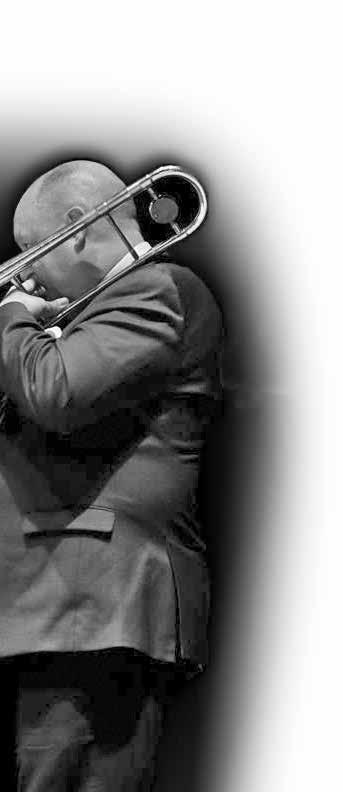
working on some opportunities to try and record her as a solo artist for my label, Miles High Records. I hope to accomplish this.”
Sakamoto’s main influence on trombone, she said, was “J.J. Johnson. I like his sound and rhythm a lot. When I listened to his playing for the first time, I was shocked. I didn’t know anyone who could play so clearly, fluently, and rhythmically. The first transcription I made of him was ‘Billie’s Bounce’ from his album, At The Opera House (a live album recorded in 1957 with Stan Getz on the Verve label). After that, I transcribed many more of his solos. I also like his original tunes and arrangements. My teacher in Japan, Hirotsugu Sakemoto, is also a big influence on my playing. He was actually the person who made the decision of switching me to trombone back then. Other important influences on my playing are trumpet players such as Clifford Brown, Freddie Hubbard, and Tom Harrell. I have transcribed and studied their music.”
In New York, Sakamoto said, “Everyone I met has been very kind

and helpful, despite my English not being very good when I arrived.” In addition to Herring, Davis, and Sherman, “Bassist John Lee helped me a lot. He offered me such unique opportunities to play, and the experience I have gained from playing with him will certainly stay with me throughout my music career.”
Like every jazz musician, Sakamoto’s live jazz appearances came to an abrupt end in March due to the coronavirus. As she waits for the live music scene to recover, she has started offering online trombone lessons. “Everyone can take lessons from all over the world,” she said, “and I can teach in English or Japanese. The topics are basic training, jazz theory, improvisations, and how to play with a big band.” Potential students can contact her via email at nanasakamoto.tb@gmail.com.
“Bassist John Lee helped me a lot. He offered me such unique opportunities to play, and the experience I have gained from playing with him will certainly stay with me throughout my music career.”
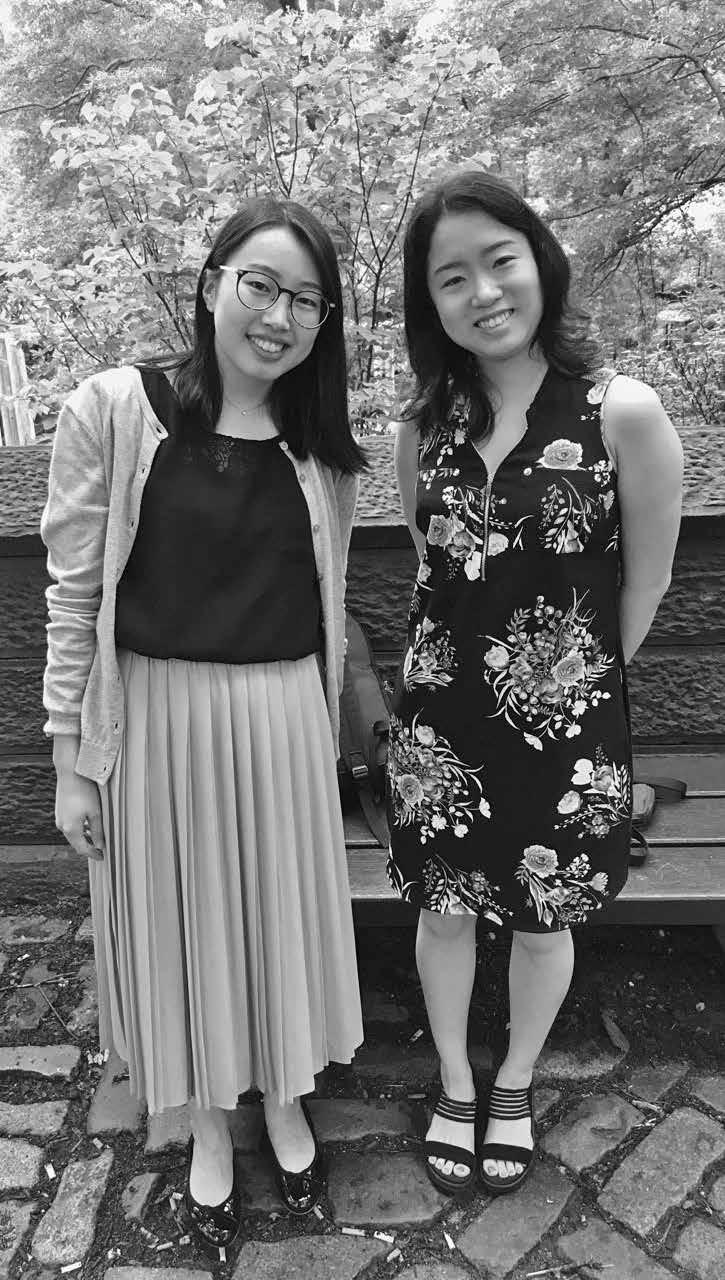

July / August 2020 15
Nana Sakamoto, left, with saxophonist Erena Terakubo.
The Challenges of Creating a Virtual Big Band Video
By Schaen Fox
Julius Tolentino is the Director of Jazz at the prestigious Newark Academy in Livingston, NJ Despite its size, the small private school has repeatedly made it to Jazz at Lincoln Center’s annual Essentially Ellington competition. This year, Tolentino has led the band to score another notable achievement. Rebounding from the pandemic chaos, he guided his student musicians in creating one of the very first high school virtual big band videos on YouTube.
I asked him what it was like for his students when they learned that the school was shutting down, and they had to finish the school year from home. He said, “It was almost a grieving process. At first there was shock then disbelief, especially in our seniors. This was their last hurrah, but they picked themselves up. Now they have actually finished all their classes, and their spirits are coming back. I had such a strong senior class this year, I wanted to quickly get something of high quality out there. I think the seniors are happy. That’s always going to be on YouTube, and they were all part of it.”
Tolentino is both a superb musician and a dedicated teacher. Perhaps that is something he gained from his mentor Jackie McLean. For him the lockdown was initially devastating. “I felt really defeated with what I needed to do and how to do it.” Fortunately, the school was prepared. “Newark Academy was incredible in getting ahead of this. This school outdid itself in terms of the training they gave us and putting all the things in place to have all of the students on the same page. The toughest transition was trying to figure out my own individual class: How I was going to get the students playing together and give them certain projects. I’ve had experience teaching online, so, I was used to the process. When I realized that this was primarily what I’d be doing, I went back to the school, got some nice microphones and a bunch of other things that made teaching online more productive and a lot easier.

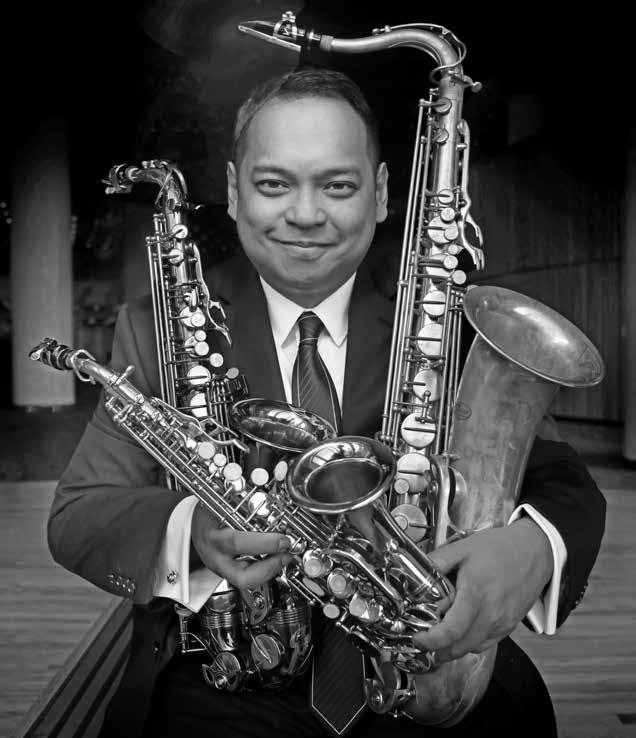
“I was up and running almost since the beginning,” he continued, “but the process of working with the students was really, really tough. I wasn’t able to achieve some of my goals for them, but I found that in doing some of these virtual projects that we just had to readjust some of these goals. The ultimate goal of everybody improving every day as musicians, and helping them in that journey was still being achieved. I’m learning a lot of other things that I probably wouldn’t have if this hadn’t happened.
“When you are trying to play as a group virtually,” he said, “you don’t have the luxury of being in the same room and hearing the vibrations of everybody right next to you. Doing it myself as a professional musician, you really have to hone in to the time in a different way. I always tell my students that everybody is a drummer. They are equally responsible for the time. When

16 July / August 2020 NEWARK ACADEMY JAZZ BAND
Julius Tolentino
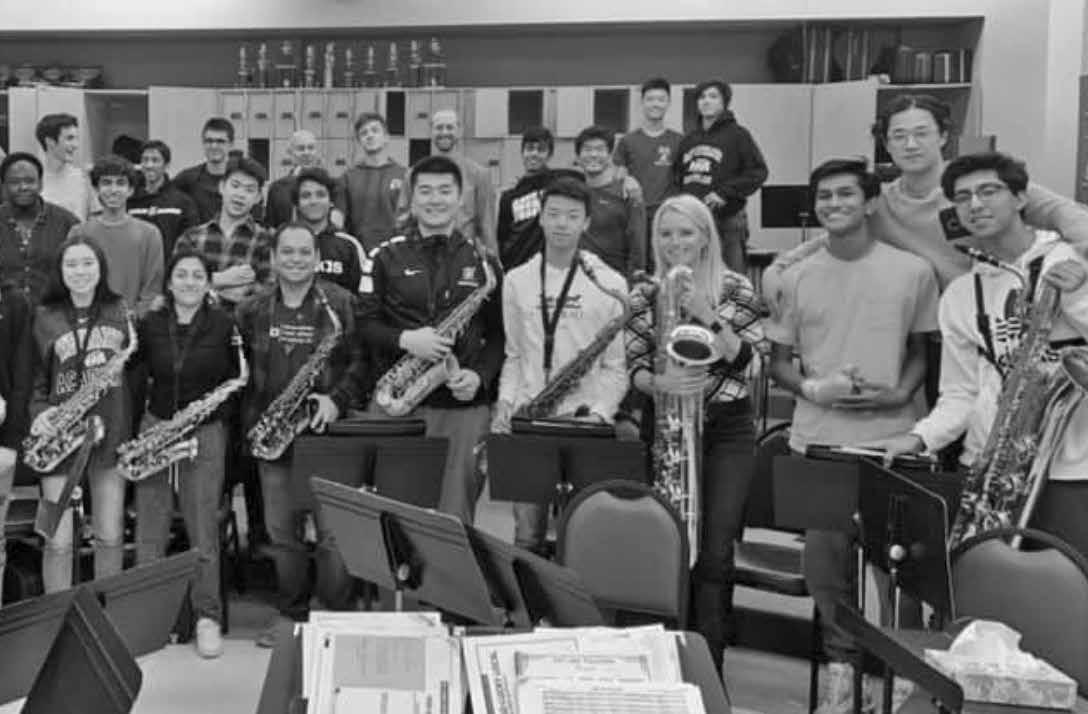
recording virtually that really comes out. I’m asking them to dig in a little deeper and really have that rhymical accuracy and intonation. That is truly harder to do when you are not right next to somebody, so, a lot of things I asked some of these kids to do are difficult for professionals. It was putting them in almost a studio situation.”
When I asked how much time it took, Tolentino laughed and said, “I really wish I had counted the hours. This was my first virtual project, so there was a lot of trial and error. Most virtual projects are like this: you decide on a composition, then you start a guide track which is either in a program, or you have one rhythm section player start, maybe playing the bass. Next we had to add the drums, then add the horns on top of that playing the melody. It took maybe two weeks to get the students to just submit something that was worth putting together. It was really a learning curve for them. It took a lot of time for me to teach them how to figure it out. Then you have to track all the sounds to the videos. I learned two new platforms within a month -- Logic and Final Cut Pro -- so there were a lot of headaches with that. It was literally like three weeks of constant work. I mean long, long hours of full work, days every day, and the weekend to just produce that two minute and a half video.
“In terms of teaching the students, I would say, ‘I need you to go back and look at this part and do that again.’ I didn’t take different

bits and pieces from different recordings, although you can. I wanted the students to really own what they produced. Taking bits and pieces would have been less educational for the students. I find creating these virtual groups really teaches them about playing in time, being super independent with their articulation and intonation, and just the way they need to feel the music on a higher level to execute what I’m asking them to do. It is definitely a different awareness that they weren’t used to. The students really stepped up and played wonderfully.”
When I asked him how this new experience compared to taking his students to Essentially Ellington, he replied, “I really do love the satisfaction of being the first swinging virtual high school big band putting something high level out there. The work it took was very much a lot in my hands, which was fun. It was kind of like the same feeling when we are building up to Essentially Ellington at the end of the year. Then we have a wonderful performance on stage and its documented. That’s probably more amazing. If I had to pick one, I’d pick that. Nothing beats playing together as a group and sharing that experience with an audience. That’s special.”
To view the band’s video, visit YouTube and type in Virtual Big Band, Newark Academy’s Jazz Band Chameleon, ‘This Can’t Be Love’ Yasmeena Sharif- Vocals.
July / August 2020 17
Newark Academy Jazz Band at Charles Mingus Festival & High School Competition in February.
Lauren Sevian: ‘When We Get Back Together, We Won’t Take It for Granted’
By Sanford Josephson
While baritone saxophonist Lauren Sevian was attending the Manhattan School of Music in the late 1990s, she began playing with the Diva Jazz Orchestra, the all-female band founded by drummer Sherrie Maricle in 1993. In those days, Sevian recalled, “Diva was one of the only all-female bands that was officially out there.”
Times have changed. Sevian is part of Lioness, a sextet that also includes alto saxophonist Alexa Tarantino, tenor saxophonist Jenny Hill, guitarist Amanda Monaco, organist Akiko Tsuruga, and drummer Allison Miller. She also co-leads a quintet with Tarantino called LSAT (the two leaders’ initials).
When the Jazz Journalists Association announced the winners of its 2020 JJA Jazz Awards in May, Sevian was named Baritone Saxophonist of the Year, following up on two 2019 awards: the DownBeat Critics’ Poll “Rising Star” award on baritone and the Hot House Magazine Baritone Saxophone Award. Fourteen of the 25 JJA performer awards were given to women. In addition to Sevian, drummer Terri Lyne Carrington was named both Musician of the Year and Drummer of the Year; another Diva alum, Anat Cohen, was voted Clarinetist of the Year; and Allison Miller’s band, Boom Tic Boom, was selected as Mid-Size Ensemble of the Year. (A complete list of the JJA winners can be found at www.JJAJazzAwards.org).
The JJA award, Sevian said, “feels great. I’m very honored to be recognized in that way because there were so many great baritone players nominated.” Like all of her musical peers, Sevian has seen her live performances canceled for the foreseeable future. “I’m going to be doing some remote teaching through Jazz House Kids,” she said. “The faculty is kind of rotating on a weekly basis.”
Reviewing Lioness’ album, Pride & Joy, released on the Posi-Tone label in March 2019, AllAboutJazz’s Dan Bilawsky wrote, “If there’s a line to hang over this release, it’s ‘I am woman, hear me roar and rejoice.’” He described the sextet as “six female instrumentalists with serious firepower and vision.” The album, he continued, highlighted “their composing chops while also shining a light on some respected elders.” The band, Sevian said, “had a bunch of gigs lined up for the summer,” which, of course, were canceled. “Now,” she added, “we’re slated to play at the Northampton (MA) Jazz Festival in October.
In 2018, Sevian led a quartet on the Posi-Tone album, Bliss, which included Tarantino on alto, Christian McBride on bass, and E.J. Strickland on drums. JazzTimes’ Britt Robson called the album “a career-crystallizing showcase,” adding that Sevian “plays the deep, fullbodied baritone sax with the spry agility of an alto saxophonist.” Sevian actually started out on the alto saxophone. “My teacher,” she recalled, “suggested I try the baritone. I said, ‘I don’t want to play that thing. It’s huge.’ But after I tried it, I said, ‘Oh, my God, I love this thing. I just totally want to play this.’ Then, he laid all these Pepper Adams recordings on me. Then my teacher gave me recordings of Nick Brignola and Gerry Mulligan.” Later, other influences were Cecil Payne and Gary Smulyan.
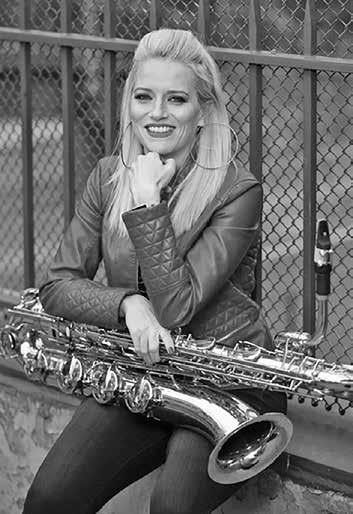
As a member of the Charles Mingus Big Band, she is participating in Facebook Mingus Monday Live performances online, which normally would be live at the Jazz Standard in New York. “We’ll continue to do the weekly performances,” she said, “but we’re expanding to give lessons and workshops.” In addition to Sevian, musicians such as pianists Helen Sung and David Kikoski, saxophonist Wayne Escoffery, and guitarist Freddie Bryant are doing weekly lessons, “playing new numbers and talking about the music. It gives our community a chance to continue the tradition. We have the power with this technology to connect with people all around the world. The more we can celebrate, the better off we’ll be.” Sevian has been a member of the Mingus Big Band since 2003 and was on the 2011 Jazz Workshop, Inc. album, Live at the Jazz Standard, which won a Grammy Award.
Lioness appeared at Dizzy’s Club last December and also played live in the studio on Gary Walker’s Morning Jazz program on WBGO.
When I interviewed Sevian for my book, Jeru’s Journey: The Life and Music of Gerry Mulligan (Hal Leonard Books: 2015), she told me that during her freshman year at MSM, “for a month, all I did was listen to Gerry Mulligan. I couldn’t get enough of his sound on Birth of the Cool. I remember listening over and over to ‘Venus de Milo’.”
New Jersey Jazz Society members may also remember Sevian as part of the Billy Strayhorn Orchestra, led by alto saxophonist Michael Hashim at a June 2015 centennial tribute to Strayhorn at the Mayo Performing Arts Center in Morristown. Sevian was featured on the only song of the afternoon not composed by Strayhorn (but arranged by him). As Jersey Jazz reported in its July/August 2015 issue, “The Paul Whiteman Orchestra’s pop tune, ‘I’ll Buy That Dream’ had a bari lead and a light and airy Nelson Riddle feel. Ms. Sevian also soloed on the following ‘Lament for an Orchid’, a return to Strayhorn’s more exotic side.” Sevian has fond memories of that concert. “It was such a fun band. I’d worked with Mike in George Gee’s band. I remember when he first talked to me about doing that project. The charts were wonderful.”
Sevian said she was “starting to see people do duos, six feet apart in the park. Everyone just wants to play. At some point, we’ll all be together again because the world needs it. We need to keep creating on our own so when we get back together, we won’t take it for granted. I’m definitely hungry to play with people again.”

18 July / August 2020 JJA BARITONE
THE YEAR
SAXOPHONIST OF
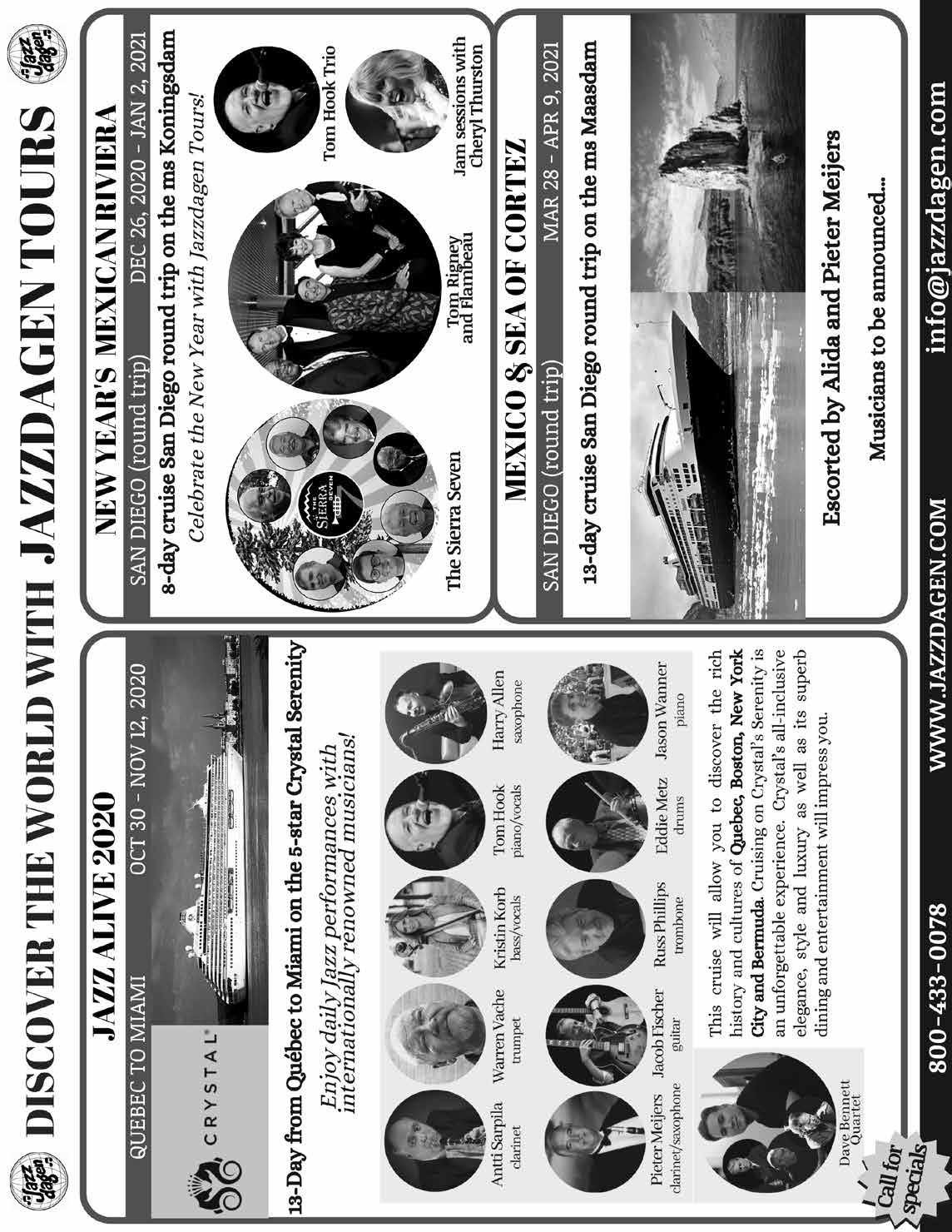

July / August 2020 19
James Taylor and John Pizzarelli Collaborate on an Album of Standards
By Sanford Josephson
“John Pizzarelli is a living encyclopedia of the best popular music that the West has ever produced.”
That’s a quote by James Taylor from the liner notes of his new album American Standard (Fantasy: February 2020). “Like his father, Bucky,” Taylor continued, ‘he is a master guitarist and a casual, matter-of-fact genius.” Pizzarelli, who produced the album along with Taylor and Dave O’Donnell, was contacted by Taylor “out of the blue” in 2017. “He said, ‘I want to do an album of standards, and ‘you the man’,” Pizzarelli recalled. As for the liner notes praise, “I was really moved. That was very kind of him.”
The two first met in 2001 when Pizzarelli performed on “Mean Old Man”, on Taylor’s 2002 Columbia album, October Road. “I also worked with him in 2002 with John Williams and the LA Philharmonic and at Tanglewood,” Pizzarelli said. “And, I did his Christmas album with Dave Grusin (James Taylor at Christmas, Columbia: 2006).
Pizzarelli visited Taylor at his barn/studio in Western Massachusetts in May 2017, “and we started to play guitar together. Our vibe together was really amazing. All of a sudden, we started to do these duets, and we realized it was going to be a guitar centric record.” Taylor explained, in the
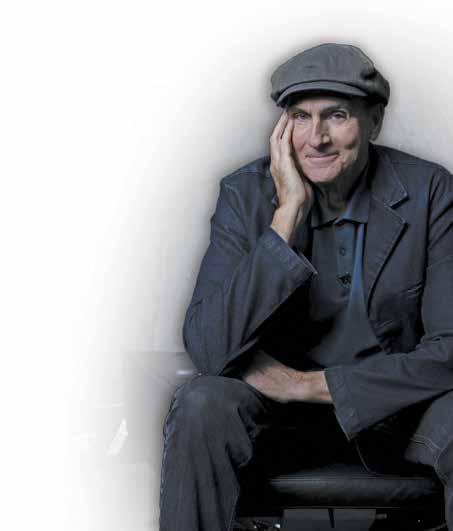
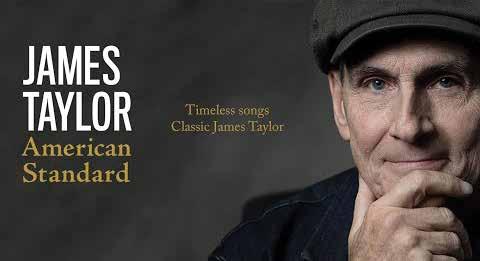
liner notes, that, “My usual MO is to show my changes to a piano player, who takes the arrangements to the band. But there was something extraordinary in the sound of just the two guitars, and I was determined to keep that sound at the center of the whole project.”
Their initial meeting played a key role in the selection of songs for the album. Pizzarelli and Taylor spent a day “going through fake books. He asked me for a few ideas, but he had all the songs on a table with titles on post-it notes -- songs like ‘My Blue Heaven’ (Walter Donaldson/ George A. Whiting) and ‘Pennies From Heaven’ (Arthur Johnson/Johnny Burke).
We were having dinner after the first break, and James’ wife, Kim, asked me about some songs and songwriters. I told her I was a fan of Johnny Mercer, and then I realized that it was Johnny Mercer who said in the Gene Lees biography (Portrait of John: The Life of John Herndon Mercer, Hal Leonard: 2006) that he was a fan of James Taylor. Johnny Mercer called James Taylor ‘Jimmy Taylor’ in the book. And, then I named a few songs, and one of them was ‘Moon River’, and Kim’s eyes lit up, and she said, ‘James -- Moon River -we have to do that.’”
That’s the moment the Henry Mancini/ Johnny Mercer classic, “Moon River”,
20 July / August 2020 JerseyJazz
photo credit: James Taylor photos by Norman Seef

‘OUR VIBE TOGETHER WAS REALLY AMAZING’

became part of American Standard. In his review of the album, AllMusic’s Timothy Monger wrote about Taylor’s “tender vocals, especially on his sweet rendition of ‘Moon River’, a song so well-suited to him it seems like it should have already existed before now. This sense of pleasant familiarity more or less guides the entire album,” Monger continued, “as he turns ‘Teach Me Tonight’ (Gene DePaul/Sammy Kahn) and ‘It’s Only a Paper Moon’ (Harold Arlen/Yip Harburg/Billy Rose) into James Taylor songs written by other artists.”
In the liner notes, Taylor mentioned that, “as a kid growing up in North Carolina, we listened to the cast recordings of the great American musicals: Guys and Dolls, Oklahoma!, My Fair Lady, Brigadoon, Peter Pan, Showboat, South Pacific . . Before I started writing my own stuff, I learned to
play these tunes, working out chord changes for my favorite melodies.”
Five of those Broadway show tunes are included on the album: Lerner & Loewe’s “Almost Like Being In Love” from Brigadoon, Frank Loesser’s “Sit Down,
You’re Rockin’ The Boat” from Guys and Dolls, Rodgers & Hammerstein’s “You’ve Got To Be Carefully Taught” from South Pacific and “The Surrey With The Fringe On Top” from Oklahoma! and Jerome Kern and Oscar Hammerstein’s
included his “regular family of players who tour and record with me” when the album was recorded in September 2017. One of those regular players is saxophonist ‘Blue’ Lou Marini, a veteran of the Blues Brothers Band. He met Taylor at John Belushi’s house in 2001, and “the next thing I knew, I got called to do a tour of 65 concerts.” Throughout his association with Taylor, he said, Taylor coined a term, “hornworthy. He will say, ‘I think this one might be hornworthy.’ I think 80 of his tunes have horns in them. Sometimes, in the nicest way, we (Marini and trumpeter Walt Fowler) will say, ‘We think we can have horns on this.’
“When James told us what he was doing (re American Standard), he mentioned he wanted contributions from everyone. I brought all my horns -- tenor, alto, soprano, clarinet, bass flute, alto flute, penny whistle. That album was so beautiful and relaxing.” Marini’s soprano saxophone is an integral part of “Almost Like Being In Love”. There is a clarinet solo on “As Easy As Rolling Off A Log” (M.K.Jerome/Jack Scholl), and his alto flute joins Fowler’s trumpet on “The Nearness of You”.

“Ol’ Man River” from Show Boat. Another song on the album, Hoagy Carmichael and Ned Washington’s “The Nearness of You” was previously recorded by Taylor on Michael Brecker’s 2001 Verve album, Nearness of You: The Ballad Book.
Although the two guitars are the centerpiece instrumentally, Taylor
The “beauty of this album,” said Pizzarelli, “is that it sounds like James Taylor but not at the expense of the music. He has a point of view that comes across. It’s a testament to how great an artist he is. He knows exactly where the chords go. He makes the music shine. It’s a unique record of standards.”
Before the arrival of the pandemic, Taylor planned to play music from American Standard as part of a national tour this summer. It was canceled, of course, but two 2021 dates are scheduled for New Jersey: July 7 at the PNC Arts Center in Holmdel and July 9 at the BB&T Center in Camden.
July / August 2020 21 JerseyJazz
“Blue” Lou Marini
John Pizzarelli Photo by Jacob Blickenstaff
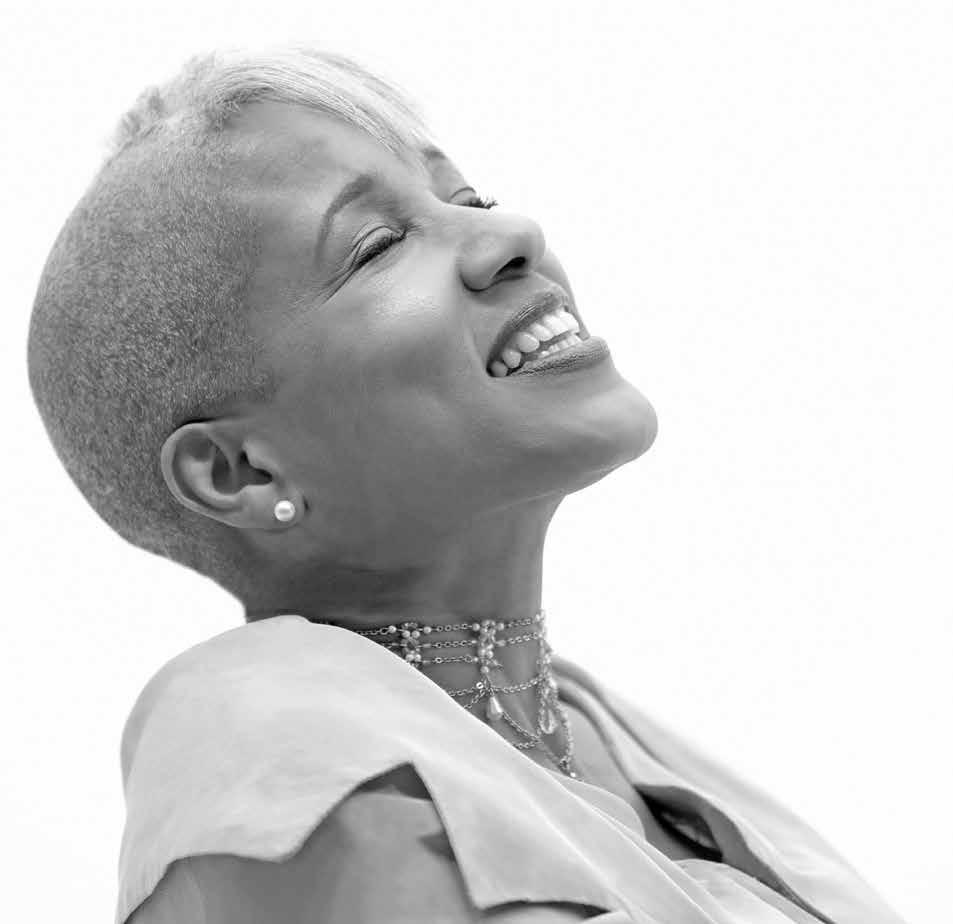
A Jersey Jazz Interview with Rene Marie
By Schaen Fox
This past March, NPR’s “Jazz Night in America”, hosted by Christian McBride, selected singer/songwriter Rene Marie as one of its three subjects for Women in Jazz programming. (The others were saxophonist/vocalist Camille Thurman and bassist Linda May Han Oh). The set list included three of her original songs -- “I Like You”, “Go Home”, and “Colorado River Song” -- as well as Rodgers & Hammerstein’s “Surrey
With the Fringe on Top”. The program notes pointed out that Marie (who didn’t start singing professionally until after she turned 40) “is the rare
jazz vocalist who has put songwriting at the very heart of her enterprise, addressing the human condition through an unvarnished personal lens.”
JJ: What do you see as both advantages & disadvantages of beginning your present career in your 40s?
RM: The disadvantage, I don’t think, was the age. It was that I just didn’t know anything when I started singing. The perception that other musicians had, because of my age – and this viewpoint is very understandable – was, “Oh, she’s 42; she’s singing jazz, she must know these famous musicians and have some experience doing this and that.” I didn’t. The disadvantage was overcoming people’s assumptions about me, and being honest about it.
I’ll never forget this conversation in the green room. [Laughing] I had just started singing, and had a gig on a cruise ship. The musicians were sitting around and talking, and as was my habit, I was just listening, because I wanted to learn. I had learned very quickly not to pretend that I knew more than I did because I would always get found out. They were talking about the Heath Brothers.
One turned to me and asked, “Which one do you think is the most talented?” I said, “I don’t know who the Heath Brothers are.” You could have heard a pin drop for a couple of seconds, then outrage. “What?” They all jumped on me. I thought it was hilarious. The guy asked me “If you don’t know who the Heath Brothers are, how did you get this gig?” I said, “I got it the same way you did: my booking agent.” We had the same booking agent, and I was proud of myself for answering that, because he was trying to dis me.
Something happens to you when you are in your 40s. (She’s now 64). I didn’t realize it at the time, but looking back I saw my 40s as this time in my life when I was really able to say no. A lot of people in the music business will play on your insecurities, your feelings of not having enough, and your fear. They will say, “If you don’t do this, there is always somebody waiting to take your place.” That didn’t bother me. I was just, “Okay. I’ll just go back to working at the bank.” It was not a big dream of mine to be self-employed as a singer. That was never my goal, but it did happen.

22 July / August 2020 TALKING JAZZ
JJ: I love the story about how your son’s phone call led to your career. Would you please tell it for those unfamiliar with it?
RM: I had two cassette tapes and an album at home (in Denver). The album was Cleo Laine, and the cassettes were one of Sarah Vaughan, and one of Ella Fitzgerald. I sang those songs all the time. My son called me. He was at a restaurant where there was a trio and a singer. He called and said, “Mom, you have got to come to the restaurant and listen to the singer. She is singing all the songs that you do, and she is terrible.” I drove to the restaurant, sat with him, and we listened. I said, “Wow! I cannot believe she is getting paid for this.” She wasn’t terrible, just boring. I don’t think it was the type of music that she loved to sing. You can be good at something, and do it because you are good at it, but you might not have any love for it. So you are bored with it. The people were talking over the top of her. The musicians were bored, and of course their playing would be boring if they were bored. They weren’t looking at her. They were watching the TV over the bar that was on mute. I was flummoxed, and thought it a travesty.
That is when my son said, “Do it Mom. You can do even better than that.” I said, “No way. I am too old to start doing something like that.” We talked about it as a family that night at the dinner table. My now ex-husband said, “Yeah, sure. Go ahead and do it. It will be a nice little hobby for you.” Patronizing and condescending, but I heard the “Yes,” so I thought, “Okay, so and so has a quintet.” I asked if I could sing with his group. He said that they ran a jam session at the Ramada Inn every Wednesday night right across the street from the bank I worked at. The musicians were very patient with me. One suggested that I learn to scat. I learned how to hold a microphone the correct way, how to trade fours with the musicians, how to engage the audience talking, how to lose my selfconsciousness, and really get into the music.
JJ: How long did it take to again be back on stage on your own?
RM: I had my own band, and started getting my own gigs, within a year. The problem with singing at a jam session every week is that if you don’t have charts in your key, then you have to sing in the key the band already knows. Very few people can play a song in any key without a chart. I learned how to make up my own charts in my own key. That is when my husband told me I had to stop when he saw that I was getting serious. People from the Jehovah Witnesses Kingdom Hall would come to our gigs, and talk to me about it when we would see them at our meetings. (Marie and her husband became members of the Jehovah Witnesses faith when they were in their teens). My husband did not like that, so he told me to stop.
I stopped for three months. Then I begged my husband to please let me keep singing. I wince internally when I quote myself on that, but those were my words, “Please let me keep singing.” I’m nothing like that now. Now I say, “I wish somebody would try to tell me I can’t sing.”
Finally the day came when I had enough money to record a CD. I was working on the charts, the night before we were to go into the studio. My husband said, “That’s it. You call the band now, and tell them you can’t record. Furthermore, cancel your gigs, because you are going to stop again, and that is final.
I sat there for about 10 seconds analyzing my options. [Laughs] The question was not do I want to sing? The question was do I want
to live with somebody for the rest of my life who thinks it is okay to issue an ultimatum like that? Of course, the answer was No! It was obvious what I needed to do. I grabbed my suitcase, and started putting my stuff in there. That is when things got violent. I picked up my suitcase, but I put my music in the car first, because I knew I was not coming back.
JJ: Let’s go with a lighter tone, because that is a tough story. Has anything of importance in your career taken place in New Jersey?
RM: Well, I learned a big lesson at Shanghai Jazz in Madison. I was there for a gig so early in my career that I was still living in Richmond, Virginia, where I moved after I left my husband. I had met a bass player named Clarence Seay. He played with Wallace Roney and was always talking about Wallace this, Wallace that. And I knew that Wallace’s wife’s name was Geri. So at the gig, my manager ran up to me and said, “Oh my goodness Rene guess who is here, Geri Allen.” I’m thinking, “Geri Allen, I know that name from somewhere.” He walks me over to a table, with Geri and her family, but Wallace wasn’t there.
My manager introduced me saying, “This is Geri Allen.” It finally hit me when he said that, and I said, “Oh yes, you must be Wallace Roney’s wife.” I didn’t know anything about her being a musician. She got a look on her face, and I knew I had said something wrong, but I didn’t know what. My manager rushed me away from the table and said, “She’s a famous piano player. Don’t you know that?” I said, “No. And don’t you ever pull me over to a table again without telling me who they are and why I should know them.” {Laughs] That was embarrassing.
JJ: Are you still getting responses for your “Star Spangled Banner”/”Lift Ev’ry Voice and Sing” performance (the centerpiece of Marie’s 2011 Motema Music album Voice of My Beautiful Country)?
RM: We get reactions when we actually play it, but not in terms of emails or text messages anymore. I still have the same phone number and email address as I did, but nobody has emailed me about it for at least a couple of years. I think it is because there are so many more artists making statements now that it is not even a thing anymore. When I did that, it stood alone, which was not my intent. I was really surprised at the level of interest people took in that.
JJ: When you performed at William Paterson University in October 2018, you began your show by coming out alone, and singing that long medley a cappella. When did you start that, and why?
RM: I have been doing that for years, I think not long after I started. I don’t do it all the time, but I do it often, because I have ‘Imposters Syndrome’ really bad. Those voices start in on me, “Who do you think you are? Everybody is laughing at you behind your back.” I felt, “Oh my God. I really can’t do this.” I had a really bad case on one gig and thought, “Okay, either I’m going to have to quit, or I have to figure out a way to get rid of these voices.” The thing was I always feel like I’m being judged. I have to change what I am normally when I’m on stage in front of people. I thought, “Okay where are you the most relaxed?” The answer was in the kitchen. That is where I sing a lot. I understood that I had to find a

July / August 2020 23
continued from page 23
way to figuratively bring my kitchen on stage, because I knew it was all in my head.
The best way I knew how to bridge this huge space that is almost like a minefield between where I stood and where the audience began was to just sing “How Can I Keep From Singing.” It would remind me, “This is why you are singing, Rene. It has nothing to do with the club or who sang here before. It is just as important as when you are singing at home alone.” That was a real breakthrough for me. Singing a cappella was like shaking somebody’s hand, and looking them in the eye. I didn’t have to come across as hip or anything else, just an honest voice in the air.
JJ: When you are writing a song, do the words and music come together?
RM: I get that question a lot. The answer is, “Yeah, sometimes.” Sometimes the music comes first, and sometimes the lyrics come first. When the music and lyrics all come at one time, I know I’ve got something I really love. I initially feel something in the pit of my stomach that moves me. Once I get to the piano or singing into my recorder, it flows out; and I’m writing down the lyrics as fast as I can. Those are lovely moments. They don’t come that often, but when they do, Oh Boy! I’m sure you have moments of inspiration, we all do, but sometimes we are so busy we don’t pay attention, or we might disparage and minimize them.
JJ: Do you have any 15-minute creations such as Duke had with “Sophisticated Lady?”
RM: Yes. There might be more, but the one I always think of is “Wishes.” I hadn’t been singing long, maybe two or three years. I had signed on to the record label Max Jazz, and I was traveling. I would see a woman in circumstances I had never seen before. For instance, sitting in a bar in a hotel by herself. I’m not a person that goes to a bar just to be at a bar. I would be drawn to her, almost like I could understand why she was there. That sounds weird, but that is the only way I know how to describe it. One morning, I woke up, and this lyric came to me “Sitting in a café, ‘midst the smoke and perfume, my coffee cup is my ashtray, and I’m way past my bloom...” I sat up in bed, and I could hear this melodic strain. I got to the piano and started playing it. The quiet loneliness of it is what I was seeing in those women. I named it “Wishes,” because it is basically about wishing for things, and feeling powerless. I don’t know if it took only 15 minutes, because I wasn’t watching the clock, but I do know that when I got up from the piano, the song was finished.
JJ: You also have a one-woman show
Slut Energy Theory. Please tell us about that.
RM: When I wrote it, I had the goal of doing three more, all
connected with the first, but I had to stay off the road for a year just to do the first one. I couldn’t afford not to be on the road. I have the shows written. They are skeletal, but I have the songs and the monologue, but I don’t have the time to get it all together. I can’t wear both hats. I tried doing some musical performances and then do the one-woman show the next day at the same venue, but I cannot. I have to do one or the other.
The show focuses on the lifespan of a “slut” named U’Dean. What was her life like before, how she becomes that way, and how did she come out of it on into her golden years. It is told from the perspective of an elderly southern black woman who has died and is in what she’s been told is heaven. She doesn’t like it one bit, so she talks to the audience. I wrote the music to carry the audience from one highlight of her life to the next. It was an amazing experience to write music from that perspective.
JJ: What advice do you give to students, about having a career in music?
RM: My advice: Sing because you love to...because you HAVE to in order to live...because you can’t help it. Don’t try to be famous. Instead, develop your artistic passion, and don’t buy into the “scarcity” fear-mongering. Always remind yourself that everything is already all right.
JJ: [Baseball owner] Bill Veeck said Satchel Paige was “born to be everybody’s most memorable character.” Do you have a most memorable character that you have worked with?
RM: I’ve learned so much from so many people, I don’t know if I could list one as more memorable than another. I’ve met really well known musicians and been super impressed by their graciousness. I expected them, because they were so well known, to be a little more distant, but they were so warm and generous. I met Nancy Wilson and just thought, “Gee, if I thought I was in love with her before, now I’m just completely over the moon.” She was adorable, and so kind. We were playing at a reception for her. A lot of big names in the music business were there. I was thinking, “Oh my God! Nancy Wilson! Don’t do any songs that she has done.” She was just so sweet. She came up and talked to the band, and pulled me over to a table, just me and her. She was holding my hand and asking, “How are things going for you? Do you have a good manager?” I thought that was amazing that she was taking that time and showing that interest in me. She gave me her phone number. I didn’t think I deserved to have it, or that she really meant, “Go ahead and call me.” I never did call her, which I regret. That was a really big thing for me.
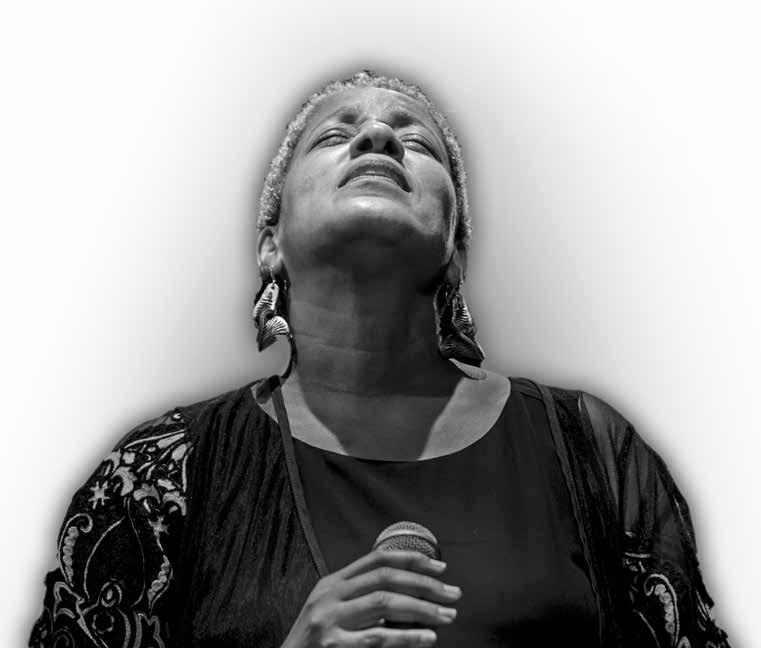
JJ: That is a nice story to end with. Thank you so much for doing this. It has been a real pleasure talking to you.
RM: Thank you so much.

24 July / August 2020
TALKING JAZZ


July / August 2020 25
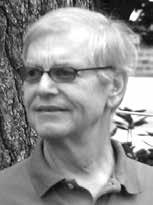
OTHER VIEWS
By Joe Lang
These days have certainly afforded me a lot of time to listen to music, and there have been a lot of new releases continuing to come in the mail, so I will do my best to choose the best of them to cover for this issue.
The JAZZ AT LINCOLN CENTER ORCHESTRA has often been presenting programs of original compositions centering around specific themes. Their two latest releases are Rock Chalk Suite and The Fifties – A Prism, both digital only releases on Blue Engine records.
Rock Chalk Suite was “commissioned to celebrate the 25th anniversary of the Lied Center of Kansas,” the performing arts center at the University of Kansas. Each of the selections is dedicated to individual coaches and players who were among the most outstanding participants in the heralded KU basketball program. There are 15 selections composed by 12 of the members of the orchestra. Among the players honored are Wilt Chamberlain, Clyde Lovellette, Danny Manning, Jo Jo White and Paul Pierce. The collection is eclectic, imaginative and consistently holds your attention. As usual, the band swings mightily, and there are sparkling solos sprinkled throughout the program. You do not have to be a KU graduate to appreciate this appealing stream of contemporary big band sounds. (store.jazz.com)
The Fifties – A Prism has six selections composed and arranged by trombonist Chris Crenshaw, each inspired by a different aspect of 1950s jazz. “Flipped His Lid” is based on the sounds of bebop, “Just A-Slidin’” finds its inspiration in hard bop, the cool sounds of West Coast Jazz underpin “Conglomerate,” Latin jazz permeates “Cha-Cha Toda la Noche,” “Unorthodox Sketches” presents Crenshaw’s take on the synthesis of jazz and classical music termed Third Stream, and “Pursuit of the New Thing” takes the listener to the world of free jazz by the likes of Ornette Coleman and Don Cherry. Crenshaw has done a yeoman job of incorporating these various aspects of 1950s jazz into exceptional big band charts, and has afforded the soloists ample space to shine. (store.jazz.com)
One of the ongoing musical pleasures in New Jersey is SWINGADELIC, the swinging group of flexible size led by bassist Dave Post. This flexibility is demonstrated on Bluesville (Zoho - 202007), a 14-tune program with the quartet assaying Mose Allison’s “Parchman Farm” and an 18-piece big band playing “Harlem Nocturne.” Most of the selections are played by small big bands varying from eight to 13 pieces. This is an eclectic program with some blues, some jazz, some R&B, and even a taste of country. Throughout it all is a blues feeling that is infectious, especially in the solo interludes. The vocals are handled by John Bauers, Vanessa Perea, Mitch Woods, and Andy Riedel. The best description for this music is smile-inducing, with dancers sure to find wonderful grooves for rug cutting. (www.Swingadelic.com)
performances pay tribute to her in a fitting manner. (concordjazz.com)
In the March/April issue of Jersey Jazz, I reviewed a series of albums featuring compositions written by the superb jazz trumpeter CARL SAUNDERS. Saunders did not play on any of these discs. Carl Saunders, Jazz Trumpet (Summit – 761) fills in that void. He is joined by pianist Josh Nelson, bassist Chuck Berghofer and drummer Joe Labarbera for a 12-song program with six of his originals interspersed with jazz and pop standards including “Recordame, “All the Things You Are,” “Sail Away,” “I Thought About You,” “Cherokee”, and “Pick Yourself Up.” Saunders is at heart a bebopper with an unrelenting sense of swing. The empathetic rhythm section provides the perfect bed for his explorations, and Nelson’s occasional solo interludes match the intensity of Saunders. You can always be assured that some of the Saunders originals will have clever titles. Here we have “Tofu or Not to Tofu” and “Dusk and Dawn,” inspired by the harmonies that he heard Joe Henderson play on his take on “Night and Day.” With Saunders you expect intensity, hard swinging, imagination and humor. They are all present here! (www. summitrecords.com)

On October 22, 2016, an impressive gathering of musical talent was present at the Apollo Theater in Harlem to celebrate the coming centennial of the great Ella Fitzgerald. The music from that evening is now available on Ella 100: Live at the Apollo! (Concord Jazz – 00280). Co-hosted by David Alan Grier and Patti Austin, the other vocalists included Afro Blue, Andra Day, Ayo, Cassandra Wilson, Ledisi, Lizz Wright and Monica Mancini, backed mostly by the Count Basie Orchestra, augmented by a string section on some selections. Some of the pieces use charts originally written for Ella. There is a spirit of love for Ella throughout the concert, and the
Ballads dominate The Art of Intimacy, Vol. 1, the latest release by trumpeter JEREMY PELT. With assistance from pianist George Cables and bassist Peter Washington, Pelt caresses eight selections, broken up just past the halfway point by the quicker tempo of “Ebony Moonbeams ,” a catchy piece composed by Cables. The balance of the program has familiar tunes such as “Little Girl Blue,” “Then I’ll Be Tired of You” and “I’ll Never Stop Loving You;” and lesser heard selections that include “Always on My Mind,” (not the Willie Nelson hit), “I’ve Just Seen Her,” a beauty from the show All American, Lucky Thompson’s “While You Are Gone,” and two Pelt originals, “Love Is Simple” and “Ab-o-lutely.” Whether

26 July / August 2020
playing open horn or with a mute, Pelt’s sensitivity is a constant. He definitely achieves artful intimacy with this album. (www.jazzdepot.com)
The JOHN FEDCHOCK NY SEXTET release Into the Shadows (Summit – 765) finds the leader/trombonist/composer/ arranger in the company of five cats with whom he has developed familiarity over the years -- trumpeter/flugelhornist Scott Wendholt, tenor saxophonist Walt Weiskopf, pianist Allen Farnham, bassist David Finck and drummer Eric Halvorson. Their talent combines with Fedchock’s arranging genius to create the impact of a larger ensemble. In this instance, Fedchock has written an eclectic collection of six originals to complement his concepts on three standards, “I Should Care,” “Nature Boy” and “Star Eyes.” When you have a band of musicians with the solo strengths that these players bring to the table, it is guaranteed that one moment of listening pleasure after another will occur. The album may be titled Into the Shadows, but the excitement that pervades this music is definitely out in the open. (www. summitrecords.com)
Pianist RANDY PORTER turns his attention to the songs of Dave Frishberg on Porter Plays Frishberg – Unsung (HeavyWood Music). With support from bassist John Wiitala and drummer Todd Strait, Porter gives his takes on 12 selections, eight of which had words and music by Frishberg, “Snowbound,” “Listen Here,” “I Want to Be a Sideman,” “Dear Departed Past,” “Wheelers and Dealers,” “Peel Me a Grape,” “Do You Miss New York” and “Zanzibar;” two with Frishberg lyrics set to music by Johnny Mandel, “You Are There” and “Little Did I Dream;” a tune by Alan Broadbent with Frishberg words, “Heart’s Desire;” and “I’m Hip” with Frishberg and Bob Dorough sharing credit for words and music. This is strictly an instrumental outing, but those familiar with the Frishberg oeuvre will surely hear the words when Porter plays the melodies. This album does give the listener the opportunity to concentrate on the wonderful melodies that are attached to Frishberg’s words. Porter and his mates do a fine job of exploring these tunes, and adding their sensitive interpretive and improvisational powers to this music. Porter has undertaken a challenging project, and succeeded mightily in creating a winner. (www. randyporter.com)

The 3D JAZZ TRIO is drummer Sherrie Maricle, pianist Jackie Warren and bassist Amy Shook. They have titled their album I Love to See You Smile (Diva Jazz Orchestra – 2020). The Randy Newman song in the title is the lead track on this eight-song program that also includes “Bésame Mucho,” “Moonglow,” “Back at the Chicken Shack,” “Angel Eyes,” “Recado Bossa Nova” “When You and I Were Young, Maggie” and “L.O.V.E.” These ladies had to be smiling themselves as they created the music on this album. There is joy in their playing, and wonderful creativity accompanying that joy. While Warren’s robust pianism is the primary focus of the music, Maricle and Shook are far from shrinking violets, making their strong presence felt at all times. This collection is guaranteed to make you smile, and that is always a good thing. (3divasjazztrio.com)
Many jazz musicians have had a strong grounding in classical music, and that experience is often reflected in their playing,
this is not the album for you, but if you are in the mood for listening to music that will touch your inner self, The Vagabond is an excellent place to visit. (mackavenue.com)
Status Sphere (Ride Symbol -25) is a duo album by tenor saxophonist VITO DIETERLE and pianist JOEL FORRESTER inspired by the music of Thelonious Sphere Monk. The 12-track program comprises six Monk tunes, “Work,” Crepuscule With Nellie,” (two takes) “Ruby My Dear,” “Let’s Call This,” “Pannonica” and “Ba-Lu-Bolivar Ba-lues Are;” and five Forrester originals that are inspired by Monk’s music. Dieterle and Forrester are years apart in age, but are kindred musical spirits. They have a natural musical empathy that shines through on every track. It takes exceptional musicianship to truly capture the spirit of Monk, but this pairing does just that, and in a way that, while often challenging, is mesmerizing. (ridesymbol.com/shop)

even in a jazz context. Pianist AARON DIEHL’s classical training is evident in his technique, compositions and improvisations. The Vagabond (Mack Avenue-1153) demonstrates all of these aspects of his artistry. He is joined by bassist Paul Sikivie and drummer Gregory Hutchinson for 11 selections, seven Diehl originals; two jazz pieces by pianists who shared Diehl’s feeling for classical music, “A Story Often Told, Seldom Heard” by Sir Roland Hanna, and “Milano” by John Lewis; and from the world of classical music, Sergi Prokofiev’s “March from Ten Pieces for Piano, Op.12” and “Piano Etude No 16” by Philip Glass. The word that comes to mind when listening to this collection is contemplative. If you are looking for swinging jazz piano trio music,
Tenor saxophonist VITO DIETERLE leads his quartet, with Kris Kaiser on guitar, Ben Paterson on organ and Aaron Seeber on drums, for a nine-tune outing titled Anemone (Ride Symbol – 30). Dieterle is masterful playing ballads. On this occasion “Dream Dancing,” “Lush Life,” “Chelsea Bridge” and his own “Anemone” benefit from his emotion laden approach. When the tempo picks up, as it does on Tommy Turrentine’s “You Said It,” Stanley Turrentine’s “Minor Chant,” Dizzy Gillespie’s “That’s Earl. Brother” and Thelonious Monk’s “Work,” Dieterle shows chops galore. The program is filled out with a swinging take on “Just in Time.” The quartet has an organic togetherness, and each player of the rhythm section has ample space to demonstrate their individual artistry. Like the flowers that inspired the tune giving the album its title, this collection has music of many colors, vibrant and attractive. (ridesymbol.com/ shop)
When the name of tenor saxophonist ERIC ALEXANDER is mentioned, most jazz enthusiasts think first of his blazing technique, primarily at quicker tempi. His ballad playing has too often taken a back seat, but on Eric Alexander with Strings (HighNote – 7330), the emphasis is on his wizardry as a ballad player. Alexander is joined in the rhythm section by long-time colleagues pianist David Hazeltine, bassist John Webber and drummer Joe Farnsworth, plus a lush string section supplemented by flute and French horn, arranged and
July / August 2020 27
OTHER VIEWS
continued from page 27
conducted by Dave Rivello. The program comprises six selections, Alexander’s “Gently,” Horace Silver’s “Lonely Woman,” Leonard Bernstein’’s “Some Other Time,” “The Thrill is Gone, and two by Henry Mancini, “Dreamsville” and “Slow, Hot Wind.” There is only 37 minutes of music on the album, but it is a rich 37 minutes. The pairing of an outstanding jazz soloist with a string section has become a familiar format ever since the legendary recordings by Charlie Parker with strings, but often they lack the kind of jazz sensitivity that is associated with the feature player, devolving into a semi-hip easy listening situation. There is none of that happening here.
Alexander is his usual imaginative and swinging self, set in arrangements by Rivello that enhance his formidable creativity. The result is a program that demands repetitive listening. (www.jazzdepot.com)
NAT KING COLE’s early recordings were released in a box set titled Hittin’ the Ramp: The Early Years (1936-1943) that was reviewed in Jersey Jazz in the January/ February 2020 issue. For those who are interested in just a taste of those sides, there is now a digital only release, Straighten Up and Fly Right (Resonance), that includes one track, “This Side Up,” that was not in the set. This collection of highlights from the box set, curated by Will Friedwald, is a satisfying look at the early Cole. (amazon. com)
New Jersey is home to a lot of fine vocalists, and one of the best of them is SUSIE MEISSNER. Just dig her new album, I Wish I Knew (Lydian Jazz), and you will understand that statement. She combines a her smooth and appealing voice with great taste in material, impeccable phrasing full of jazz influences, and perceptive choices in deciding which musicians to support her. This collection has 12 songs, all terrific, but none overdone. The opener, “The Great City,” is probably the least familiar on the program, but it sets a nicely swinging base for what is to come, “I Wish I Knew,” “It Could Happen to You,” “I’ve Grown Accustomed to His Face,” “Poinciana,” “Alfie,” “Hello Young Lovers,” “The Shadow of Your Smile ,” “Ev’ry Time We Say Goodbye,” “In a Mellow Tone,” “You Go to My Head,” and a fitting closer, “The Party’s Over.” Tenor saxophonist Larry McKenna, clarinetist Ken Peplowski, valve trombonist John Swana, and pianist John Shaddy all have ample solo space, and each
is superb. McKenna is among the most under-recorded great players on the scene, and just hearing him on “Alfie” and “Ev’ry Time We Say Goodbye,” as well as his exchanges with Peplowski on “It Could Happen to You,” are reason enough to add this album to your library. (susiemeisner. com)
LINDA PURL has had a varied career, acting on stage, screen and television, as well as singing in musicals, clubs, concerts and on recordings. The last of these activities is most recently demonstrated on Taking a Chance on Love (Reaching Records –8495022), a nicely paced 12-track album. Tedd Firth, the peerless accompanist is on piano and supplied all but one of the arrangements for the disc. To fill out the rhythm section are David Finck on bass and Ray Marchica on drums, with Nelson Rangell along on reeds. Purl opens the program with a natural pairing of “Pure Imagination” and “Never Never Land,” the only chart by John Proulx. Also paired are “Lucky Day” with “I’m Shooting High” and “And We Will Fly” with “Come Fly with Me.” Purl is a confident singer who treats each lyric with respect. Firth’s arrangements emphasize the jazz feeling that underlies Purl’s vocalizing. Purl has given us a pearl of an album. (www.lindapurl.com)
Aimez-vous bien! (Self-produced) is a thoroughly charming album by ANDREA CARLSON containing a dozen songs sung in French, all of French origin, except “C’est le printemps,” a French language version of “It Might as Well Be Spring.” There are three selections that have their origins in France but became popular over here with English lyrics added: “C’est si bon (It’s So Good),” “La mer (Beyond the Sea)” and “Les feuiles mortes (Autumn Leaves),” each of which Carlson performs in both languages. There is one song “Aimez-vous, aimez-vous bien!” that Carlson co-wrote with Jean-Claude Testarode. Two other tunes will be familiar to most listeners, “Nuages,” the classic with music by Django Reinhardt, and “Petit Fleur,” composed by Sidney Bechet. The cast of musicians varies from track to track. Of particular note is the presence of Larry McKenna’s magnificent tenor sax magic on five tracks. Overall, Carlson is well supported by her Philadelphia area musicians. The primary attraction is listening to the vocals of Carlson, who has a great feeling for the music, and delivers, at least to this nonFrench speaking chap, a credible job of delivering the French lyrics with her wonderfully engaging sound. You will
certainly find yourself repeatedly revisiting this music. (www.AndreaCarlsonMusic. com)
It is a constant joy to discover how many current performers are keeping the music of the 1920s and 1930s alive and vibrant. Among them are SAMOA WILSON with the JIM KWESKIN BAND. They have recently released I Just Want to Be Horizontal (Kingswood Records), 17 songs that will bring a smile to your face. Wilson has a voice and approach to these evergreens that is spot on. Among the selections are “After You’ve Gone,” “Trust in Me,” “That’s Life I Guess,” “Me, Myself and I,” “Kitchen Man,” “He Ain’t Got Rhythm” and “Someone Turned the Moon Upside Down.” Kweskin’s band includes a couple of NJJS favorites, Mike Davis on trumpet and cornet, and Dennis Lichtman on clarinet, fiddle, mandolin and alto sax. They lay down a perfect bed of sounds for Wilson’s highly listenable vocalizing. This collection will bring back many memories, but these folks bring a freshness to the music that keeps it from sounding dated. (www.samoawilson.com)
After becoming a steady presence on the New York City jazz/cabaret scene for several years, SUZANNA ROSS has released her debut album, Suzanna Ross Is Bewitched* (Self-produced). Listening to her perform the 15 selections on the disc, she certainly proves to be a confident singer who is a welcome addition to the world of recorded vocalists. To support her are pianist Gregory Toroian, who also did the arrangements, bassist Sip Ward and drummer David Silliman. The program is interesting and eclectic. There are songs from Broadway, “Mr. Wonderful” and “My Favorite Things”; film, “Summer Me, Winter Me,” “Laura,” “Over the Rainbow” and “Live for Life”; and television, “Theme from ‘Bewitched”. She takes a look back to the catalogs of Nat King Cole, “Come to Me, Do” and Marlene Dietrich, “Boomerang Baby.” Also present are a Jobim tune, “Dreamer;” and a couple of pop songs, “Haven’t We Met” and “There’s a Kind of Hush.” Ross usually includes some French songs in her live performances, and she adds a trio of them here. No matter the material, Ross knows how to effectively approach it. She has produced an impressive first recording. (suzannarozss. com)
For additional Other Views, log onto www. njjs.org after July 1.

28 July / August 2020
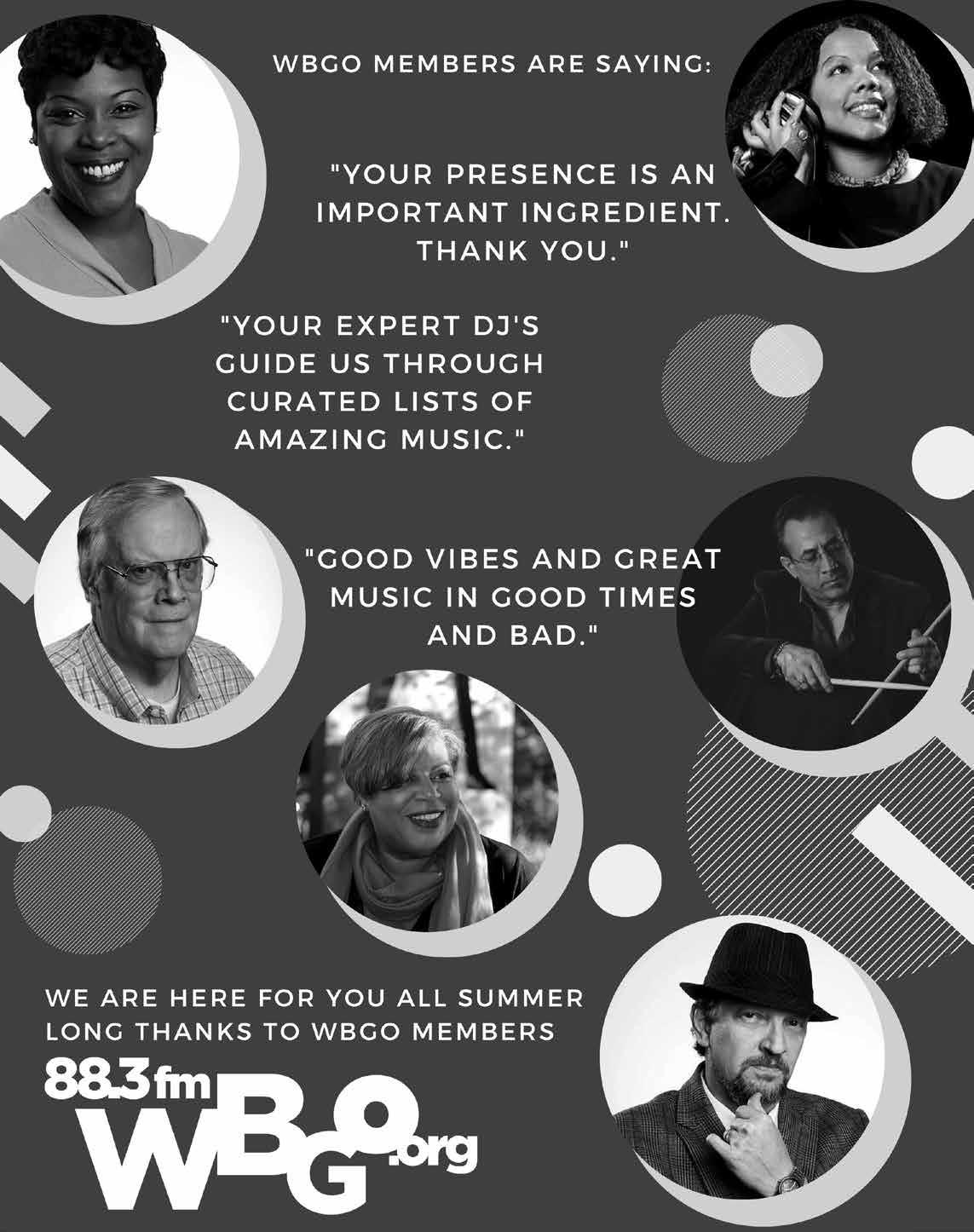

July / August 2020 29
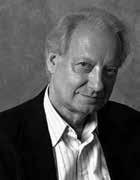
DAN’S DEN
By Dan Morgenstern
I’d love to have something happy to write about, but these are dark days. Among those we’ve lost is a great name in jazz (and was a dear friend). Happily he lived to be 92, but I always thought he’d reach 100, as he well might have.
It’s Lee Konitz of whom I speak, and speaking with him in public was our last encounter, in August of 2017 at the Jazz Museum in Harlem’s series of conversations. As always he was kind, often funny, and without a trace of vanity. And he was still an active player (and singer -- when he started his career in his native Chicago he sang as well as played). This was a kind of natural link to the man who became Lee’s greatest influence, Lennie Tristano, a great teacher as well as a marvelous pianist, who made his students SING recorded jazz solos, by the giants. And near the end of his life, Lee started to sing again, beautifully, in the same spirit as he played his alto, in a style all his own, in which he was able to establish himself when Charlie Parker was dominant. Lee admired Bird but wanted to be his own man, which he surely became.
I first became aware of Lee by way of the wonderful records he made with Tristano and his front line partner, tenor man Warne Marsh. The way these two voiced and phrased their horns together produced a unique sound that I fell in love with when I heard “Marionnette,” Lennie’s take on “September in the Rain” (as I figured out much later) on Symphony Sid’s late night radio show. And I first caught Lee live, by surprise, at one of the Monday night sessions a still young Birdland was then offering, sharing with Stan Getz in place of Warne. (It was my first live encounter with that master as well.)
he soon acquired fans among musicians. (When I was in the Army, stationed in Germany, in the early ‘50s, every alto player I encountered was trying to sound like Lee, a kind of Jewish victory in the Nazi aftermath.)
Back home he linked up with Tristano again, if not for long -- I caught them with, amazingly, Art Taylor on drums. Lennie had favored more discreet backing. In fact, Lee had to free himself from Lennie’s influence, which did not endear him to Tristano fans, who were an odd bunch of insiders. And speaking of drummers, Lee later recorded with Elvin Jones, on a 1961 album called Motion, an experiment in completely unrehearsed spontaneous music making. He also teamed with the fine guitarist Atilla Zoller, Hungarian born.

Lee, of course, came to first full attention by way of his work with the famous-to-be Miles Davis Nonet. It’s seldom noted, for some odd reason, that this was an arranger-composer’s group: Gil Evans, John Carisi, John Lewis, Gerry Mulligan. It was an outgrowth of the Claude Thornhill big band, not Lee’s first but surely best, for which Gil arranged. Lee’s lovely playing on “Moon Dreams” has not dated and never will.
Thornhill was not Lee’s first big band but for some time his last, until he unexpectedly joined Stan Kenton, who had a great ear for alto players (Art Pepper, Charlie Mariano and the great forgotten Dave Schildkraut. Mingus mistook him for Bird on a Blindfold Test). It didn’t last long but exposed him to new ears. Lee then began leading his own groups and spending time in Europe, where
In fact, from this point on, Lee spent much time in Europe and also recorded prolifically, in all kinds of settings. (I tried to keep up but was incomplete.) Back home, Norman Granz recorded him with strings. Lee was also reunited with Warne. They recorded together in Denmark. Perhaps his greatest European partner was the brilliant French pianist Martial Solal, of the same age and originality.
Lee formed a nonet in the ‘70s, with arrangements by Sy Johnson and a very young drummer named Kenny Washington. They had a gig right across the street from where Lee lived, probably the easiest access in jazz history. That apartment he shared with his second wife who was into Scientology, but she failed to enlist Lee, who was married three times and fathered five children, two sons and three daughters, winding up with a great granddaughter! On one of my few jazz cruises, I met Lee’s third wife, a sweet German girl named Gundula. The Nonet recorded for Hank O’Neal’s Chiaroscuro label; I did the notes and dubbed it “Yes Yes Nonet,” a pun, as you no doubt guessed, dear reader, on No No Nanette (a musical some of you are too young to recall). Lee’s last recording was also with a nonet, with a slightly different instrumentation from the others. I assume my dear colleague Joe Lang will write about it; DownBeat gave it threeand-a-half stars, so generous for the last survivor of the Birth of the Cool still playing great at 92. I wrote a letter to the editor stating that I would give Lee five stars just for breaking wind; it was printed, with a photo of Lee. I hope he got to see it.

30 July / August 2020
Dan Morgenstern with Lee Konitz at the National Jazz Museum in Harlem.
Simply Timeless Radio’s Classic Jazz Now Available On NJ Jazz Society Website
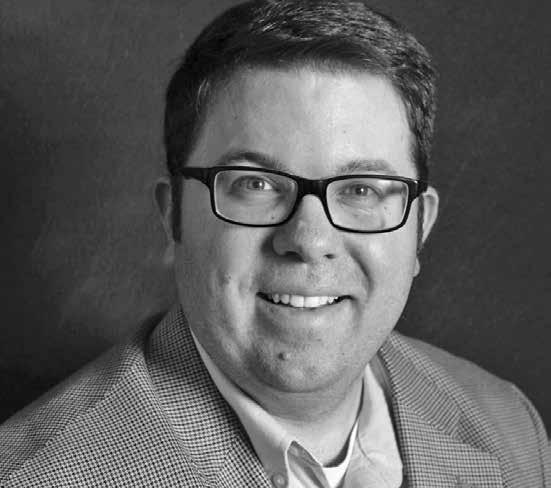
Simply Timeless, a radio program created in 2017 by jazz pianist and vocalist Jay Daniels, can now be heard on the New Jersey Jazz Society website, www.njjs.org. In early May, NJJS and Daniels formed a partnership that will also include collaboration on promoting jazz events and news items from New Jersey and the surrounding region.
Since its beginning, Simply Timeless has featured the sounds of classic jazz artists such as Nat King Cole, Ella Fitzgerald, Miles Davis, Harry Connick, Jr., and Norah Jones. “The New Jersey Jazz Society,” said Cydney Halpin, NJJS President, “is thrilled to partner with Jay Daniels and Simply Timeless as further commitment to our mission to preserve and promote America’s art form -- jazz. Jazz lovers are going to enjoy this well-researched, well-crafted, and very enjoyable program.” Content on the Simply Timeless Radio program is updated every Friday.
Simply Timeless has grown from a locally-based program in Greencastle, PA, to a globally syndicated two-hour weekly program, headquartered in the Tri-State Area. This July, Simply Timeless is featuring a four-week series called “Celebrating America”. Each week, the program will present songs about the states, cities, and landmarks throughout our country. Some examples: Hoagy Carmichael’s “Georgia on My Mind”, “Moonlight in Vermont” (Karl Suessdorf/John Blackburn), and “I Left My Heart in San Francisco”, made famous by Tony Bennett and written by George Cory and Douglass Cross.
Daniels, who grew up in Mineral, VA, northwest of Richmond, began playing the piano at age seven. He played mostly church music until he discovered jazz in his late teens, becoming captivated by the music of traditional artists such as Louis Armstrong, Ella Fitzgerald, and Billie Holiday.
To listen to Simply Timeless, log onto www.njjs.org and click on the Simply Timeless icon.
Not without YOU!
Your membership is vital to NJJS’s mission to promote and preserve America’s great art form – jazz! Thank you and welcome to all who have recently joined or renewed their memberships.
We can’t do what we do without you !
* Three – year Membership † Gift Membership
Names in bold type - Patron Membership
RENEWED MEMBERS
Gerry Cappuccio, Pasaaic, NJ
Richard Davala, Lakewood, NJ
William Dodwell, Florham Park, NJ*
George H. Elwood, Utica, NY
Mr. & Mrs. David Engberg, Chalfont, PA
T.L. Feibush, Woodbridge, NJ
Sandy Grossman, Springfield, NJ
Harold James, East Orange, NJ*
Paul Kopf, Morristown, NJ
Marilyn Kreinberg, Livingston, NJ
Joe Lang, Chatham, NJ
Ronald Lilly, Fanwood, NJ
Dick Lowenthal, Lake Worth, FL
Frank Marrapodi, Watchung, NJ
Arthur Mattei, Lawrenceville, NJ
Thomas McEvoy, Ridgewood, NY
Joan Meeker, Roseland, NJ
Brent Mills, Bedminster, NJ
Anthony Moschetta, Parsippany, NJ
Gene Perla, Easton, PA
Suzanne Robinson, West Orange, NJ
Ron Schneiderman, Bridgewater, NJ
Daniel Scott, Flanders, NJ
Donald Shaw, Denville, NJ
Daryl Sherman, New York, NY
Robert And Viola Smith, New Providence, NJ
Nicholas Smolney, Old Bridge, NJ
Howard Stoll, Hamburg, NJ
David Yager, Philadelphia, PA
NEW MEMBERS
Mike Lee, Montclair, NJ

July / August 2020 31
The Music Drives the Drama in the Story Of a Troubled Paris Jazz Club
By Sanford Josephson
Growing up in Los Angeles, keyboardist Randy Kerber was a junior high school classmate of alto saxophonist Ted Nash, now a member of the Jazz at Lincoln Center Orchestra. Nash’s father, Dick, was a first call trombonist in the movie studios, and when Kerber was at Ted’s house, he would hear stories about composers such as John Williams and Henry Mancini. “I remember those days at the Nash house very fondly,” Kerber said. “I met Ted in junior high, and we went all the way through high school together: jazz bands, competitions, everything. Ted’s dad, Dick, is a world-class trombonist and was very encouraging to young aspiring musicians. He knew that I loved film scores and was fascinated by the whole process, so he invited Ted and me to a few sessions to check it out.”
Early in their careers, Nash and Kerber played with big bands led by Lionel Hampton and Don Ellis. But, while Nash moved eastward, Kerber stayed on the West Coast and has had a thriving career as a film studio keyboardist. He’s worked on more than 800 movies and was nominated for an Oscar for his work with Quincy Jones and trumpeter/arranger Jerry Hey on the movie, The Color Purple. “I orchestrated everything we wrote together and ended up conducting our cues as well,” he recalled. “I’m really proud of what we came up with because everything had to be run by Quincy and Steven Spielberg. If the music didn’t work for them, then it didn’t make the cut. Fortunately, our music stayed in the picture.”
Kerber’s latest project was playing piano, acting and co-composing the music with
six-time Grammy Award winner Glen Ballard for the Netflix series, The Eddy, which premiered on the streaming service May 8. It’s the story of a jazz club in Paris whose owner, Elliot, played by Andre Holland, is threatened by gangsters. The first two episodes were directed by Damien Chazelle (La-La Land, Whiplash), who is also one of the executive producers.
The band members -- with the exception of Joanna Kulig, who plays the vocalist, Maja -- had
said, “I’m not sure about Joanna’s plans for a singing/ recording career, but she is absolutely brilliant at anything she touches, so it wouldn’t surprise me if plans are in the making.” While the acting is superb by everyone throughout the eight-episode series, there is special electricity when Kulig -playing sort of a cross between Anita O’Day and Peggy Lee -- is on the screen.
One particularly inspiring scene in the third episode, involves the

little or no acting experience. “We got thrown in the pool with the acting thing,” Kerber said. “Damian [bassist Damian Nueva Cortes] and Lada [drummer Lada Obradovic] had more comprehensive work with our on-set dialogue/acting coach, Dany Hericourt, but for us other three (trumpeter Ludovic Louis and saxophonist Jowee Omicil, in addition to Kerber) it was kind of the learnby-doing method.” As for Kulig, who received critical acclaim for her role in the 2018 historical drama movie, Cold War, Kerber
transition -- Maja’s idea -- from a somber, religious funeral to a jazz funeral at the home of the deceased’s widow. When the family returns home, they are surprised by a New Orleansstyle jazz celebration. That scene, Kerber said, “was very important to Glen, drawing from his New Orleans roots. We orchestrated that scene to start with a second line progression and then have it morph a few times until it ends up in an allout jam, fusing jazz and North African music. I think it worked very well.”
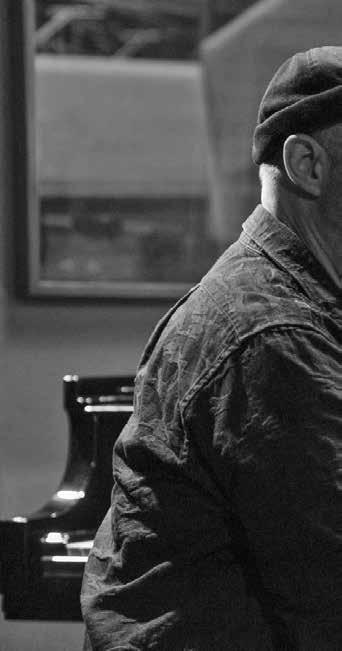
Ballard is a songwriter, lyricist, and record producer best known for producing and co-writing Alanis Morrisette’s Jagged Little Pill, the 1995 Maverick alternative rock album that won five Grammy Awards including Album of the Year. “Both Glen and I share a love for jazz that goes way back,” Kerber said. “As far as the writing process, in some of the cases, we started literally from the ground up -- me at the piano, free styling and Glen catching it on his phone, while writing lyrics. In other cases,

32 July / August 2020 THE EDDY
The band performs on The Eddy stage. Photos courtesy of Netflix.
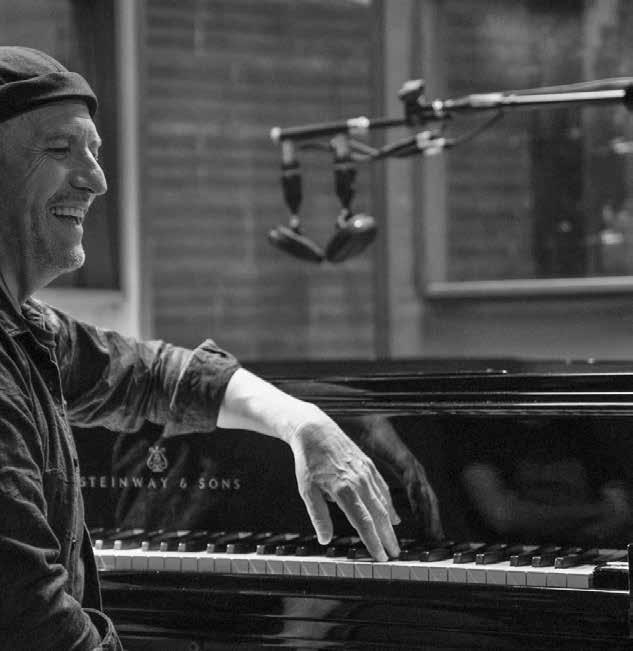
Glen had a tune started and would bring me in to help complete it. Sometimes we’d get together and say, ‘Let’s do a real up-tempo burner today’ or ‘something mid-tempo and sexy.’”
The music was a mix, ranging from swing to hard bop, with North African, Caribbean, and Eastern European influences. “All of the players in the band loved playing together,” Kerber said. “Every one of them really got the material embedded in their bloodstream, so when we played, we could just let go and have a great time! What’s on film is the actual joy of performing. All of us cannot wait to play The Eddy songbook live in concert!”
Another jazz connection among the actors was revealed by Amandla Stenberg, who plays Elliot’s daughter, Julie. In an interview with British Vogue’s Hayley Maitland, she said, “I’m

“All of the players in the band loved playing together. Every one of them really got the material embedded in their bloodstream, so when we played, we could just let go and have a great time!”
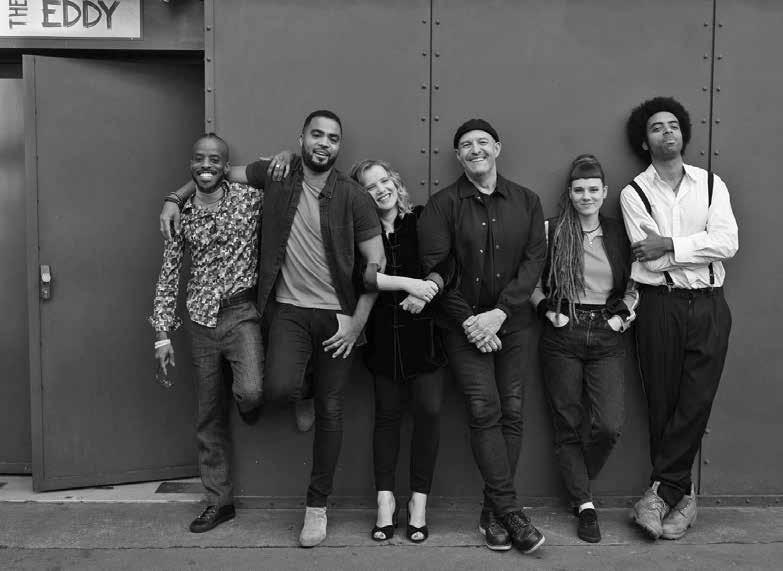
named after a Miles Davis album, (Amandla, Warner Bros.: 1989), and I’m really familiar with the history of jazz. What I had to educate myself about more broadly was how Paris had been this refuge for African-Americans through the years.” That background was also important to Holland, who told The Washington Post’s Sonia Rao, “If we’re going to tell a story about jazz and have two black characters in the center of it, I felt strongly that we damn
well better recognize the real people who made this possible.” In one scene, Elliot gives Julie a copy of James Baldwin’s collection of essays, The Price of a Ticket, and says to her, “You know, there’s a whole history of us in this place.”
The Eddy gradually draws you in. In the beginning, you’re not sure where it’s heading, but, by the end, you wish it would keep going, particularly because of the joyous street music scene in the last episode. When the
action slows, the drama is always rescued by the music. Kerber felt the acting by the musicians “became more fluid as the season evolved. We’ll really kill it in season two, lol!” Without giving away too much of the plot, there was a loose end that could leave the door open for a second season. “I do not know the answer to that question,” Kerber responded. “But, from your mouth to God’s ears.” An album of The Eddy soundtrack was released by Arista Records in May.
July / August 2020 33
From left, saxophonist Jowee Omicil, trumpeter Ludovic Louis, vocalist Joanna Kulig (Maja), pianist Randy Kerber, drummer Lada Obradovic, and bassist Damian Nueva Cortes
Randy Kerber at the piano.
BIG BAND IN THE SKY
continued from page 12
AllMusic’s Scott Yanow, while calling it a “lesser outing” than Mercy, Mercy, singled out solos by “the young altoist Richie Cole” as one of its “notable” moments. In his obituary on the WBGO website, Nate Chinen provided a link to footage from a 1970 Rich performance, pointing out that

Cole is featured “with a solo that charges out of the gate just before the nine-minute mark.”
Cole died on May 1, 2020, in Carnegie, PA, a suburb of Pittsburgh, at the age of 72. After playing with Rich, he joined the saxophone sections of Lionel Hampton’s band and the Doc Severinsen Tonight Show band before mostly leading his own groups from the mid-1970s on.
As a leader, he embraced bebop as his signature style, often collaborating with some of its leading veteran stars such as trumpeter Red Rodney and fellow alto saxophonists Sonny Stitt and Phil Woods. He cultivated a close relationship with the vocalist Eddie Jefferson who appeared on many of his albums including his 1978
Muse release, Keeper of the Flame, which also featured Harold Mabern on piano and Vic Juris on guitar. Yanow called it one of Cole’s “best-ever albums. He rips through surprisingly effective medium-to-uptempo versions of ‘As Time Goes By’ and ‘Holiday for Strings,’ welcomes the great vocalese singer Eddie Jefferson to ‘Harold’s House of Jazz’ and ‘New York Afternoon,’ has a humorous dig at free jazz on ‘Strange Groove’, introduces his ‘Keeper of the Flame’, and comes up with a near-classic solo on ‘I Can’t Get Started.’”
After witnessing Jefferson’s murder (by a gunman) outside a Detroit nightclub in 1979, Cole, according to JazzTimes’ Michael J. West, began “a long battle with alcoholism. Professionally, he rebounded in the early 1980s with Side by Side, a recording with his mentor [Phil] Woods; a long association with the vocal jazz ensemble Manhattan Transfer; and short but electric bouts of collaboration with Sonny Stitt and Art Pepper in their final years. But, personally, he was adrift. He spent much of the ‘80s and early 1990s living a nomadic existence, stopping off for periods in Los Angeles, San Francisco, Las Vegas, and Chicago. In the late ‘90s, he returned to the East Coast, where he formed a seven-piece band, the Alto Madness Orchestra.”
Reviewing a 1998 reissue of Side by Side, originally released on the Muse label, AllAboutJazz’s Jim Santella pointed out that “Woods’ lighter, bouncier tone is quite distinct from Cole’s more forceful and direct sound,” adding that, “the duo show their allegiance to Bird with familiar, fastmoving lines that allow for individual solos and creative interplay.” Woods and Cole were joined on the album by pianist John Hicks, bassist Walter Booker, and drummer Jimmy Cobb.
In 2010, Cole moved to the Pittsburgh area where his daughter, Annie, lived. There, according to West, “He quickly became an evangelist for the city’s jazz scene, working and recording with local musicians and advocating for them tirelessly in his interviews and album notes.”
He died in his sleep of natural causes. Survivors, in addition to Annie, are: another daughter, Amanda Marrazzo; and four grandchildren.
Live Music Advocate, Lee Boswell-May
By Gregory Burrus
South Orange Village President Sheena Collum said it perfectly: “Never easy to pay tribute to someone who was one in a bazillion. Lee May, who we all called Boz, is such a tremendous loss for the South Orange community but she wouldn’t want tears or sadness.”
It was such a shock to get a call from her family telling me she has moved on to rejoin her husband Earl May in heaven. Lee was always out and about, supporting the community and being a staunch advocate for live music and the community she was raised in, South Orange, NJ. (May, born on September 24, 1945 in Orange, NJ, died April 18, 2020, at the age of 74).
Lee’s life was always deep into jazz and blues as the wife of the prolific bassist Earl May (R.I.P. 2008) who was an “idiodextrous” jazz bassist. Earl was one of those rare bassists in the history of jazz who played the instrument ‘back-to-front’ playing ‘lefthanded’ on a ‘right-handed’ double bass. He was also very well known for nurturing the careers of many musicians.
Lee was left with a mission by her husband Earl of ‘Keeping The Music Alive’. Well if you played any instrument around the South Orange area, especially the bass, Lee “Boz” May picked up that mission with a quiet vengeance. You see, Lee was known for walking up to musicians, especially bass players, at the end of an evening, a song or a set, striking up a conversation and immediately getting deep into the music. She was a very active supporter of the South Orange Performing Arts Center, working with bassist John Lee to support the annual world class Giants of Jazz concert (see January-February 2020 Jersey Jazz, pages 26-27) and was also the curator for the very popular SOPAC Jazz In the Loft program. If I did 70 Downtown After Sundown events in a season, Lee talked to 70-plus musicians at a minimum, and she did this every chance she could throughout the many
continued on page 36

34 July / August 2020
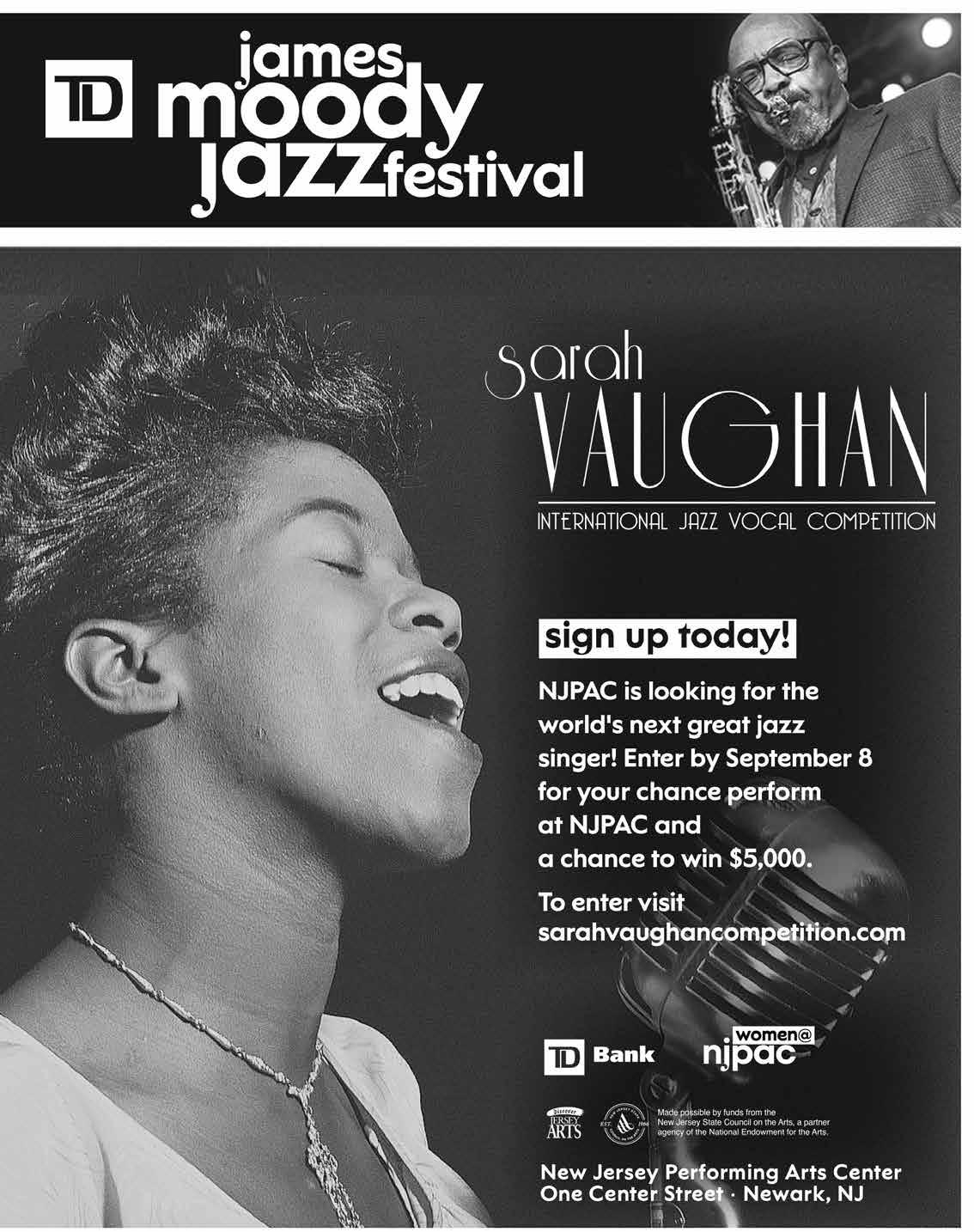

July / August 2020 35
BIG BAND IN THE SKY
continued from page 34
years of this event. Over the last few years when we provided music for the Maplewood 4th of July event in sweltering
Lee committed, she never flinched, as she was on a mission.
Lee was right there when I started Jazzy Nights at The Fox and Falcon, and she attended every one she could. It breaks my heart because she was next up on the list to be honored as a South Orange Historian and a Live Music Advocate. We had the mayor and other government officials joining us. And, of course, we had an internationally acclaimed jazz bassist from Lady Got Chops and a few other dignitaries coming out to support all the night’s honorees. Unfortunately coronavirus pulled the plug, but I know for a fact Lee would have walked right on up to the bass player and said “Hi I am Lee May.”

95 plus degree heat, Lee was right there in the sun getting folks on and off stage. When we started the Annual 24 Hours of Music events, Lee was right there noon at the Jazz On Sloan program at the South Orange Gazebo all day until I said ‘you have to go home’, and that was around midnight. Once
She supported all musicians all around our towns at our local live music venues. She was a fixture at SuzyQues and Hat City Kitchen in West Orange, and, of course, the South Mountain Blues Festival. Lee supplied her husband’s 165 yearold bass to Mike Griot who restored it and performed with the restored bass in the SOPAC Blues In the Loft program in dedication to Lee and Earl May.
Lee was on the Jazz Vespers Committee with other notable luminaries like Newark’s First Lady of Jazz, Dorthaan Kirk, and every
Jack Sinkway, Former NJJS Board Member
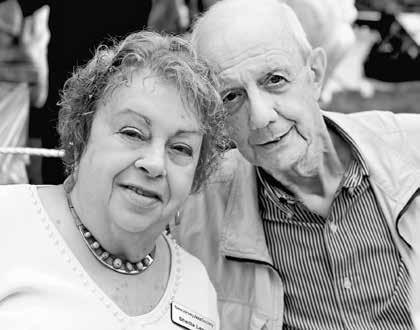
event they produced was world class. Lee was also an active Newark Bethany Baptist Church choir member. Lee was also a board member of Arts for Kids, Inc. and was always there helping out and supporting the organization. She was also a trustee of The Community Coalition on Race.
South Orange Mayor Sheena Collum phrased it this way: “As you’ve likely read or already knew, Boz was huge in the music scene, particularly her support for blues and jazz, organizing, promoting, celebratingjust all of it.”
I am very happy for the recognition of her efforts on Facebook as posts have totaled almost 500 reactions, 300 plus comments and 50 re-shares; and it still continues. I am still getting calls and messages locally and from across the country. I am also in touch with the family, and they greatly approve and love the comments being shared. To me this type of recognition by the town, the community online and offline means her efforts to know folks, nurture musicians and keep the music alive did not go unnoticed.
Lee is now in music heaven, back with the love of her life, Earl May, and together they can make even more music. Here on earth the mission is even tougher in these coronavirus distancing times but as Lee “Boz” May would say, it’s time for us to “Keep the Music Alive.”
Gregory Burrus is a South Orange-based ‘live music ambassador’, event developer, and community partner. He is a past president of the South Orange Historical Society.
Jon G. (Jack) Sinkway, a longtime Board member of the New Jersey Jazz Society, died on May 24, 2020, at the age of 83. He and his late partner, Sheilia Lenga, were passionate jazz fans and spent countless hours representing the Jazz Society at concerts and festivals throughout the state. Sinkway, for many years, also managed the sales of CDs and records at NJJS-sponsored events.
A resident of Glen Rock, NJ, Sinkway graduated from Duke University in 1959. He was co-owner of Sinkway Bros. Plumbing and Heating until he retired in 2013. In addition to his volunteer work for NJJS, he volunteered for Community Meals and the Valley Hospital, both located in Ridgewood, NJ.
Survivors include: his sister-in-law, Constance Sinkway; a nephew David Sinkway; and nieces, Robin Emery, Jody Sinkway, and Diane Stenberg. He was pre-deceased by a brother, Robert Sinkway. He was cremated in a private service. A celebration of his life will be held at a later date. Donations in his memory may be made to Valley Hospital or a favorite charity.

36 July / August 2020
Sheilia Lenga and Jack Sinkway at the 2017 Princeton JazzFeast.
Photo by Lynn Redmile
Photo by Patrick Hilaire
Jazz Studies, the Old-Fashioned Way
By Gene Perla
It was 1967. Eventually, I wanted to move into Manhattan. I saw an advertisement in the Village Voice for a four-month sublet in Greenwich Village on Bleecker Street, only a half a block off the Bowery. I made an appointment and went over to meet the people, husband and wife. His name was Daniel Nagrin. He had decided to become a modern dancer somewhere in his late 20s and had received a grant to travel to Africa for four months. I called Don Alias and asked him to join me, so on my first night in taking over the place, he came down from Boston. That’s when things got into high gear. The music took off big time!
Unbeknownst to me, Don had called his Boston buddy, Chick Corea (Chick and Don had a rehearsal trio in Boston with drummer Tony Williams where Don played bass), and at midnight there was a knock at the door and in walked Chick and Joe Farrell. We jammed, and Chick liked my playing, so he invited me to come to his home in Queens, where he was living with his family, to jam. And I went there for some months two or three times a week. It was a fabulous learning experience as Chick was tearing up the keyboard. At a particular session, after playing a very fast piece that I had difficulty in keeping up, he suggested that I count in two instead of four. Knowing Latin music, this was easy for me, and I worked on this for about a month increasing my landings first on one and three, then just one, then two measures, then four, then eight, until I was able to land on one of a 32-bar chorus and not touch down until the next chorus. At this point in life, the only thing holding me back from any tempo was my physical limitation, not my brain.
The loft was a big open space with a grand piano and there were other artistic people in the building. In the building next door, drummer Bob Moses, a good friend of David Liebman, had jam sessions regularly. While we were living in this loft, Don and I landed a gig with the Russian pianist, Vladimir Vasilyev, who was fairly famous at that time because he had defected from Russia with two other jazz musicians. He landed a gig at the Metropole, which had changed from a straight-ahead music club to a mixture of music and go-go dancing. We played with him for two weeks on a seven-hour gig from noon until seven each day, and it was a fun gig as there were great musicians. Bobby Porcelli on alto sax, Lew Soloff on trumpet, Frankie Malabe on conga, Don on timbales, Vladimir on piano, and me on bass.
I was doing a lot of gigs via the Wednesday union gatherings and ran into a fellow named James Stevenson. He screamed and yelled while playing and would smash the piano without any standard keyboard technique, but he still had something going for him with mucho emotion. For me, free jazz is about emotion, about movement of energy. Players moved along together through crashing, bashing and willowy, wispy notes. For several months, James had a weekly Sunday gig at a Brooklyn church. It was a wild experience to have him bang on that piano for a church service. Bob Moses played the drums on some of the jobs. I got paid. $5. It was so fantastic being able to regularly play music. The money was incidental.
After renting that loft for four months, I really lucked out finding another loft that I lived in for several years, a meaningful development. The building was owned by the City of New York, and the rent, including the heat, was $95 a month for a place where I could not only live, park my car in front for free, but jam day and night with very little complaints from the other tenants. One time, though, a guy above me poured water on his floor in protest, and it leaked through. Many musicians visited my loft to jam, including Mike Brecker, Randy Brecker, Steve Grossman, David Liebman, Lew Soloff, Benny Maupin, Jimmy Cobb, and many others. I hooked up with flutist Jeremy Steig doing a bunch of gigs with a girl who previously played piano with The Mothers of Invention. We played in a rock club run by Steve Paul on the West Side called The Scene where I saw Dr. John promoting his infectious album Gris-Gris. I also saw Pete La Roca playing with David Liebman and Steve Swallow.
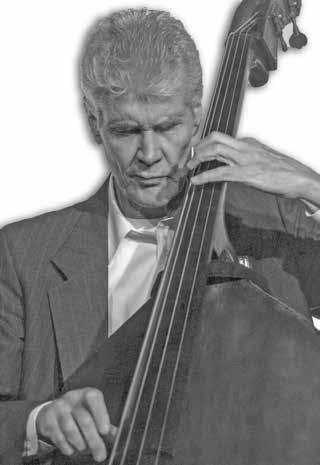
At the Bleecker Street loft, an upstairs water heater broke and destroyed the acoustic piano that came with the sublet, so I had my Mason & Hamlin grand shipped in from my folks’ home. We played so loud that one night the cops banged on the door. We decided to switch instruments and play really soft. It was quite amazing what came out. Carl Schroeder, originally on piano, picked up a viola, Don switched from drums to a single conga, Ken Carter continued on bass, and I was stroking the strings inside of the piano. It was amazing what we came up with…avant-garde, free jazz stuff.

When I moved to New York, at some point I decided that in order to become known I would go to local clubs and ask to sit in so I could get more experience. This was a practice that was commonly done amongst musicians as the time. Since I played the acoustic bass, I used to take my bass around so I would always have my own instrument to play. One night at the old Half Note downtown, I was listening to a quintet consisting of saxophonists Richie Kamuca and Zoot Sims, Ross Tompkins on acoustic piano (he later went on to join the Doc Severinsen’s TV band in L.A.), Wilbur Little on bass, and Roy Haynes on drums. Wilbur let me sit in for him that night, and Richie Kamuca was giving me a hard time about bringing my own bass, so he was telling the audience that I better play good and so forth. Being a little too bold, I said back to him, “Just watch”. So, we started to play, and I did do pretty well. They gave me a solo, and Kamuca said to the audience, “Well, he can play.”
The best advice I would give to aspiring young jazz musicians today is -- if they’ve been struck with the notion of wanting to play jazz music AND they unequivocally believe they have the capability to so -- follow your dream with fortitude. From that path, all will flow.
Gene Perla grew up in New Jersey, studying classical piano and trombone. After graduating from the Berklee School of Music, he moved to New York and began his musical career as a jazz bassist.
July / August 2020 37 GUEST COLUMN
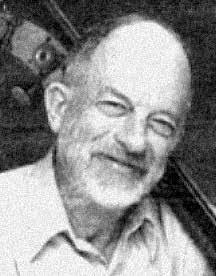
FROM THE CROW’S NEST
By Bill Crow
Back in the 1940s there was a club on Times Square called the Zanzibar. It featured headliners like Nat Cole and Louis Jordan. I was in the Army in Maryland then and visited New York on a three-day pass, but I didn’t go to the Zanzibar because it was too expensive.
A New York friend of mine had gone there once when the Duke Ellington band was in residence. He told me they had Duke’s piano on a platform which, during the opening number, was slowly lowered from an opening in the ceiling to the bandstand with cables at the four corners. Two winches operated the cables. On the night my friend was there, one of the winches failed, but the other continued to lower its two cables. The piano and Duke’s piano bench were attached to the platform, so there was no danger of them sliding off, but the whole thing was at a steep angle when they finally got the winch stopped.
My friend said that Duke never lost his aplomb. He just hooked one foot around a leg of his piano bench, continued to smile at the audience, and continued playing while the stagehands solved the problem, gradually righted the platform, and lowered Duke successfully to the bandstand. The guys in the band had continued playing, as if nothing unusual was happening.
On Facebook, Terry Gibbs told this story about the late Jack Sheldon: When Terry had his Dream Band in California in the late 1950s, he said the band was so much fun that nobody ever took off. But on a pair of one-nighters that he booked opposite Miles Davis’ sextet, trumpeter Stu Williamson couldn’t make it. So, on the advice of his alto player Joe Maini, Terry hired Sheldon. Jack was nervous on the first gig, which was on a bandstand set up on the pitcher’s mound in a ballpark in Tucson, Arizona. He was sitting at the end of the trumpet section next to Al Porcino, Ray Triscari and Conte Candoli, three of the best in the business. And he was a little unsure of his sight-reading ability.
On about the third number, a wind came up and blew Jack’s music off the stand onto the ground. Jack jumped down and continued playing his part where it had landed. The wind blew the music a little farther along, and Jack followed it, continuing to play. Terry said, “By the time I cut the band off at the end, I swear Jack was playing his part from center field!” That was the beginning of a long relationship that Terry had with a fine trumpet player who was also a very funny guy.
• • •
Saxophonist Kirby Tassos’ Uncle John wanted to be an opera singer, but to pay the rent he worked as a cameraman at NBC. In the 1940s, one of his first jobs was to film the NBC orchestra under maestro Toscanini. When Toscanini discovered that his cameraman was an aspiring opera singer, he asked Kirby’s Uncle John to sing something for him. After he sang, Toscanini said, “What a talent! He sings in all keys at once!”
Scott Robinson was playing at the Jazz on the Mountain Festival up at Mohonk Mountain House. There was a dinner hosted by WBGO, and Amy Niles was saying a few words on the microphone about “having all these incredible musicians... and each one more amazing than the last!” Cornet player Kirk Knuffke, seated next to Scott, leaned over and said, “That’s why I’m always late! •
My friend the late Jack Segal, the songwriter, told me this story long ago. When he and his first wife, Lillian, decided to get married, they flew to Maryland where it could be done quickly. On their return to New York, Lillian called her mother to give her the good news. Her mother didn’t say a word about the marriage. “You flew!” she cried. “Why didn’t you tell me? I would have worried!
•
Peter Zimmerman told me he once saw Frank Foster leading a quartet in a jazz club. Between sets, Peter told Frank that the most exciting music he ever heard was Frank’s big band, “The Loud Minority,” playing John Coltrane’s “Giant Steps,” with Frank wailing a solo over the horn sections. Peter asked him if he would play that tune on the next set.
Frank began the set by announcing that someone had requested that he play the most difficult song in the whole jazz repertoire. Peter said, “The rhythm section started in, Frank stepped up, and the first note he played was a ‘wrong’ note, after which he took a pretty darn good solo. I never found out whether he played that first note deliberately as a joke on the ‘requester.’ He had a great sense of humor, so I wouldn’t put it past him!”
• • •
Bill Crow is a freelance musician and writer. His articles have appeared in DownBeat, The Jazz Review, and many other publications. His books include Jazz Anecdotes, From Birdland to Broadway and Jazz Anecdotes: Second Time Around. The preceding is reprinted with permission from Allegro, the monthly magazine of AFM Local 802.

38 July / August 2020
• • •
• • •
• •
• •
Wharton Institute for Performing Arts
Offers Summer Jazz Listening Hour Online
The Wharton Institute for the Performing Arts (WIPA) will offer four Jazz Listening Hours in July -- at 7 p.m. on July 6, 13, 20, and 27. Hosted by saxophonist Dave Schumacher, this informal survey of the history of jazz will explore classic as well as rare, live unissued recordings generally unavailable to the public. This series, which also included a June 29th session, presents listening/discussion sessions covering the development of jazz from its early roots through swing, bebop, and beyond. Featured jazz legends include Duke Ellington, Count Basie, Dizzy Gillespie, Thelonious Monk, and others. The participation fee is $50. For more information and registration, visit www.WhartonArtsOnline.org. Said Schumacher, “Music lovers of all ages will enjoy exploring the history of America’s great art form through guided listening sessions. Whether you are a jazz newbie or seasoned fan, these sets will expand your horizons right from your living room.”
Chicago native Schumacher has been a key player in the New York jazz scene for more than three decades, touring throughout the United States and internationally with the Lionel Hampton Orchestra, Art Blakey Big Band, T.S. Monk’s Monk Ensemble, Nicholas Payton’s Louis Armstrong Tribute Big Band, and as an original member of the Harry Connick, Jr. Orchestra. Schumacher received a Bachelor of Arts degree in Jazz Performance from Rutgers University/ Livingston College and a Master of Music degree in Jazz Performance from New Jersey City University.
Wharton Institute for the Performing Arts is located in Berkeley Heights, New Providence and Paterson, NJ.
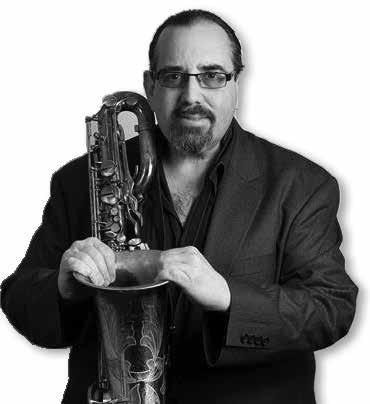


July / August 2020 39
Dave Schumacher


Send all address changes to the address above RETURN SERVICE REQUESTED PERIODICALS Permit No. 6668 Postage PAID at West Caldwell, NJ and additional mailing offices Time Value Material Deliver Promptly New Jersey Jazz Society P.O. Box 223 Garwood, NJ 07027
























































